If you're planning your holiday or searching for accommodation in Bali, the first and most important step is deciding which part of the island you want to stay in. Bali's regions are incredibly diverse, each offering something different depending on your expectations, lifestyle, personality, and who you’re traveling with.
There’s no single "best" area in Bali — the ideal place for you depends entirely on what you're looking for. That's why the question "Which is the best region to stay in Bali?" doesn’t have a universal answer. Instead, it's about finding the area that suits you best.
In this guide, you'll find tips on how to choose the right area based on your travel goals, whether you're visiting Bali for a relaxing family vacation, surfing, yoga, nightlife, or diving adventures.
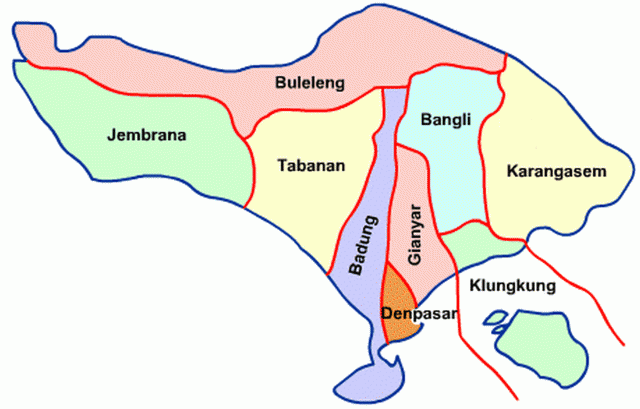
Where to Stay in Bali: Quick Recommendations
Traveling with children or elderly parents?
- If you want calm beaches with gentle waves, choose Benoa (Nusa Dua) for a short stay with a bigger budget
- Choose Sanur for a longer, more affordable stay.
Learning to surf?
- Start in Kuta, which has many surf schools and beginner-friendly waves.
Experienced surfer?
- If you're visiting during the dry season, head to Pecatu or Ungasan if you prefer quieter beaches, or Canggu, Tibubeneng, or Pererenan if you enjoy a social scene with concerts, bars, and a vibrant expat community.
- In the rainy season, Benoa (Nusa Dua) and Sanur are better surfing options.
Coming for yoga and meditation?
- If being close to the ocean matters, choose Canggu, Tibubeneng, or Pererenan.
- If proximity to the beach isn't important, Ubud is the spiritual heart of Bali.
Freelancer looking for affordable beauty?
- Choose Jimbaran for beautiful beaches and reasonable accommodation.
- For a lively social scene with concerts, cafés, and nightlife — opt for Canggu, Tibubeneng, or Pererenan.
Short trip focused on nightlife?
- If money isn’t a concern, Seminyak (or the nearest part of Kerobokan to Seminyak) is ideal.
- For a more budget-friendly option still close to clubs and bars, choose Kuta.
Diving enthusiast?
- For shipwrecks, macro diving, and easy shore dives, head to Amed.
- For manta rays, explore Nusa Penida.
- For turtles, shipwrecks, and sharks, dive at the Gili Islands.
Worried about rain ruining your trip?
- During the rainy season, consider the Gili Islands — Air, Trawangan, or Meno — where rain tends to be less intense.
Looking for a "walkable" paradise with clean air, white sand, and clear waters?
- Choose Gili Air, Gili Trawangan, or Gili Meno.
Seeking adventure and dramatic landscapes?
- Nusa Penida offers breathtaking cliffs, powerful nature, and a wilder side of Bali.
Seasonal Tip: Which Beaches Are Cleaner?
- Dry season (June–August): Winds blow from the east, so the west coast beaches (Pecatu, Jimbaran, Kuta, Legian, Seminyak, Berawa, Canggu) are cleaner.
- Rainy season (December–March): Winds shift from the west, making east coast beaches (Nusa Dua, Tanjung Benoa, Sanur) cleaner.
- Year-round clean beaches: The southern beaches (Ungasan, Kutuh) maintain their cleanliness throughout the year.
South Bali: Where Most Adventures Begin
South Bali is where most visitors first set foot on the island. From bustling beaches and lively nightlife to luxurious resorts and beginner surf spots, this region offers something for everyone. Whether you're seeking adventure, shopping, or just a taste of Bali’s famous sunsets, South Bali is where the journey begins.
Tuban
Tuban is a small district located immediately north of the airport, nestled between the runway and the southern end of Kuta Beach.
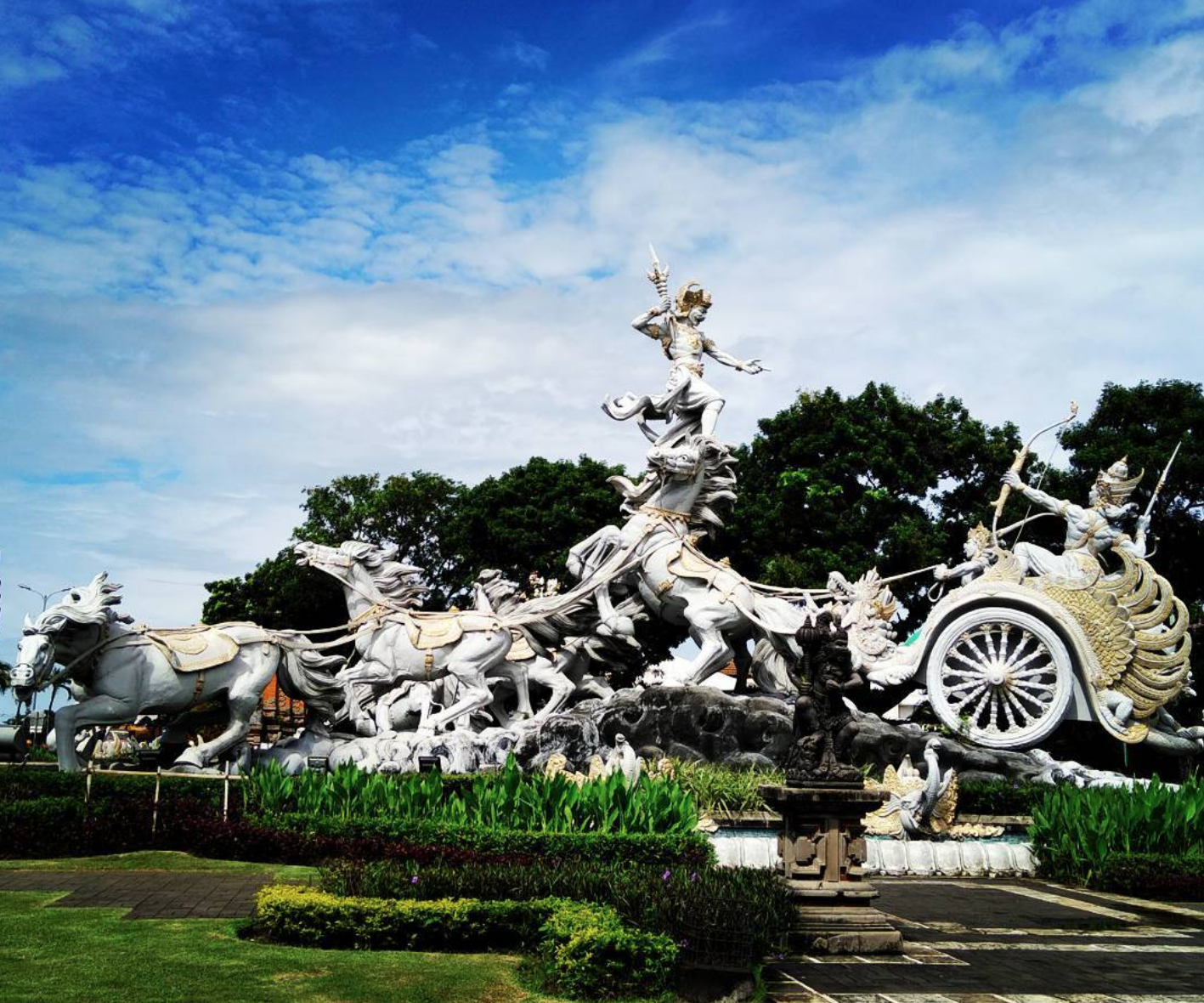
Accommodation: Tuban is primarily a local residential area, with very few hotels or tourist accommodations. However, there are a few modest hotels catering to short-term stays.
Transport: The area is very walkable due to its compact layout. However, if you need to explore beyond Tuban, scooters and taxis are necessary.
Atmosphere: Tuban is quiet and authentic, far removed from the hectic tourist buzz of central Kuta. It's ideal for travelers looking for a more local experience, while still staying close to Kuta's attractions.
Beaches: Tuban’s stretch of beach is connected to Kuta Beach. It's a pleasant spot for early morning or sunset walks, though it can be less maintained than tourist-heavy areas further north.
Pros:
- Very close to the airport (minutes away)
- Quieter and more local atmosphere than Kuta
- Affordable, local-style accommodation
Cons:
- Limited tourist infrastructure (few attractions, cafés, or nightlife)
- Beach may not be as clean or lively as in Kuta or Seminyak
Who It’s Recommended For: Travelers with very early or late flights, short-term stays, or those looking for a base very close to the airport without the chaos of Kuta.
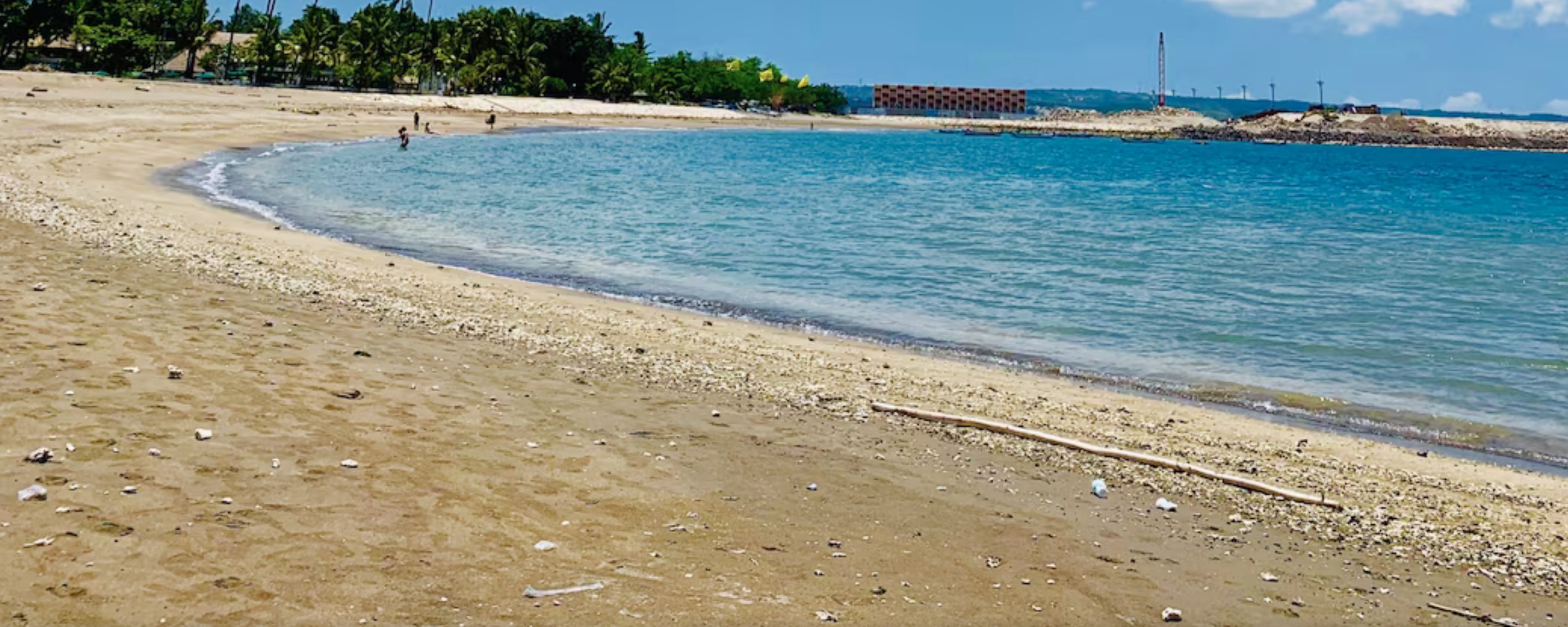
Kuta
Kuta is the first major tourist area north of Bali’s airport and one of the island’s most famous — and most divisive — destinations. People either love or hate Kuta. If you’ve only visited Kuta, you might walk away thinking you’ve seen Bali — but the reality is, Kuta is its own vibrant (and chaotic) world.
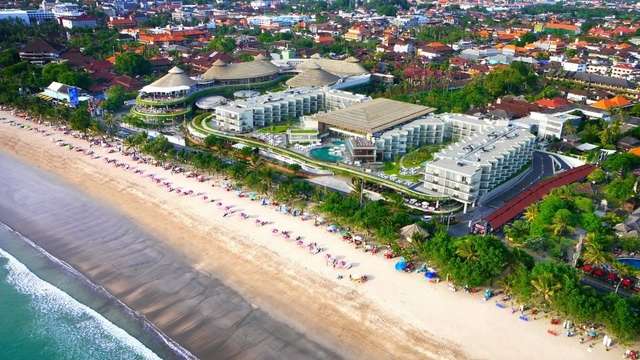
Atmosphere:
- Kuta is a dense, buzzing hub filled with narrow streets, market stalls, massage salons, and lively traffic.
- It’s loud, colorful, and packed with energy day and night.
- You’ll find some of Bali’s largest shopping centers here, including Beachwalk, Bali Galeria, Discovery Mall, and Lippo Mall.
- There are also local fruit and vegetable markets, but you’ll need to know where to look — they’re hidden away compared to the malls.
Accommodation: Kuta doesn’t offer ultra-luxurious hotels, but it does have a wide range of mid-range hotels, budget guesthouses, and hostels. Interestingly, accommodation prices here are often higher than in neighboring Seminyak, despite Kuta’s rougher vibe. Recommended hotels include The Anvaya, The Stones Hotel, and Sheraton Bali Kuta Resort.
Transport: Kuta is compact enough to explore on foot. However, traffic jams, especially along Legian Street, are common in the evenings. Online taxis are widely available and can access most places.
Sights and Entertainment: Kuta is Bali’s nightlife powerhouse. Loud music spills from clubs and bars every night, creating a charged, party-heavy atmosphere. It’s less polished than Seminyak but much cheaper — perfect for budget party-goers.
Beach: Kuta Beach stretches from the airport northward into Legian Beach. The sand is light and soft, but the waves are strong, making the beach better for surfing lessons than for calm swimming. During the dry season, the beach is relatively clean, often maintained by local eco-activists. In the rainy season, however, ocean currents bring in significant amounts of trash.
Pros:
- Everything is within walking distance
- Vibrant nightlife with many nightclubs and bars
- Numerous cheap guesthouses and hostels
- Surfing lessons available right on the beach
- Light, soft sand during the dry season
Cons:
- Very noisy and crowded
- Persistent street vendors
- Pickpocketing risk — stay alert
- Dense development with little nature
Who It’s Recommended For: Young travelers who want wild parties, quick access to surf schools, and a lively, energetic atmosphere similar to Pattayain Thailand.
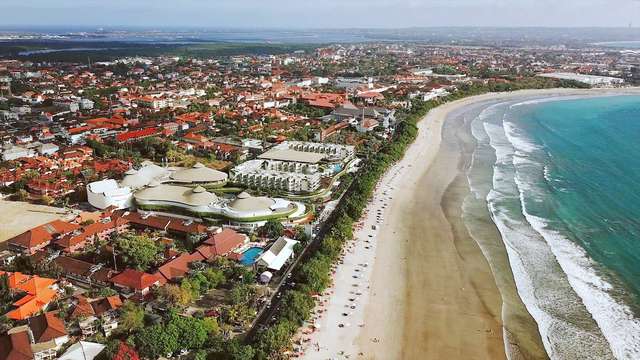
Legian
Legian sits quietly between Kuta and Seminyak, but many tourists struggle to pinpoint exactly where it begins. In reality, Legian starts just after the northern curve of Kuta Beach, where the main road turns inland toward the heart of the island.
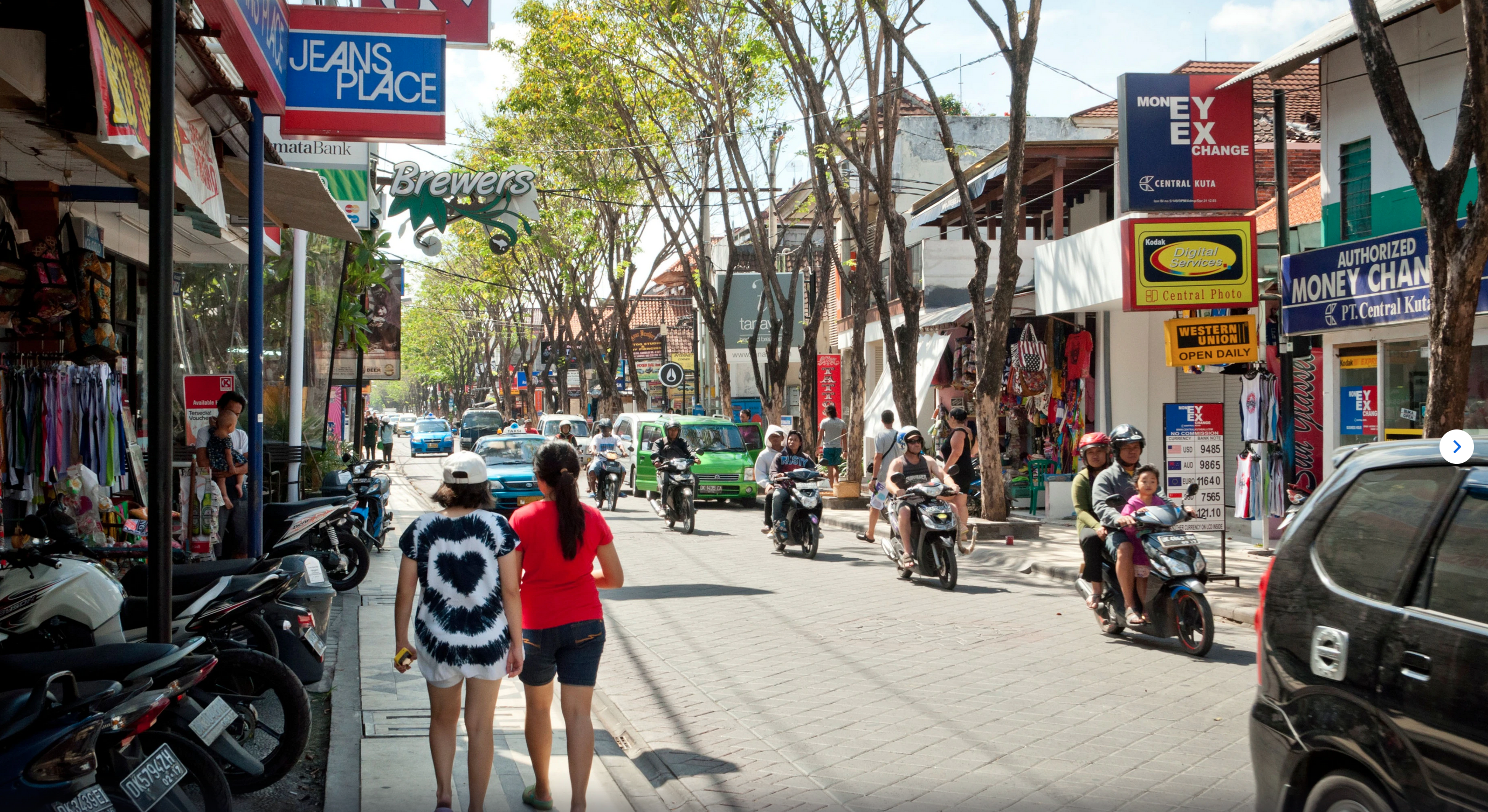
Atmosphere: Legian offers a slightly calmer alternative to Kuta, though still lively.Narrow streets are lined with souvenir stalls, clothing shops, and cafés. It's lively but without the overwhelming intensity of central Kuta.
Accommodation and Transport: The area is small enough to walk everywhere. Traffic jams are common during the day on the narrow lanes between Legian Street and Legian Beach. Online taxis operate almost everywhere without restrictions.
Sights and Entertainment: While Legian has a good selection of bars and restaurants, nightclubs are rare here — most nightlife seekers continue into Kuta or Seminyak.
Beach: Legian Beach offers a major advantage: it does not have a busy public road directly next to it, making it feel quieter and more relaxed. The sand is slightly darker than in Kuta, but the difference is minimal.
Pros:
- Easy to explore on foot
- Quieter beach compared to Kuta
- Plenty of souvenir and clothing shops
- Still relatively light sand for beachgoers
Cons:
- Densely built area
- Street vendors can be persistent
Who It’s Recommended For: Travelers who want to stay close to the airport, walk everywhere, and enjoy a lively atmosphere — but without being right in the middle of Bali’s clubbing scene.
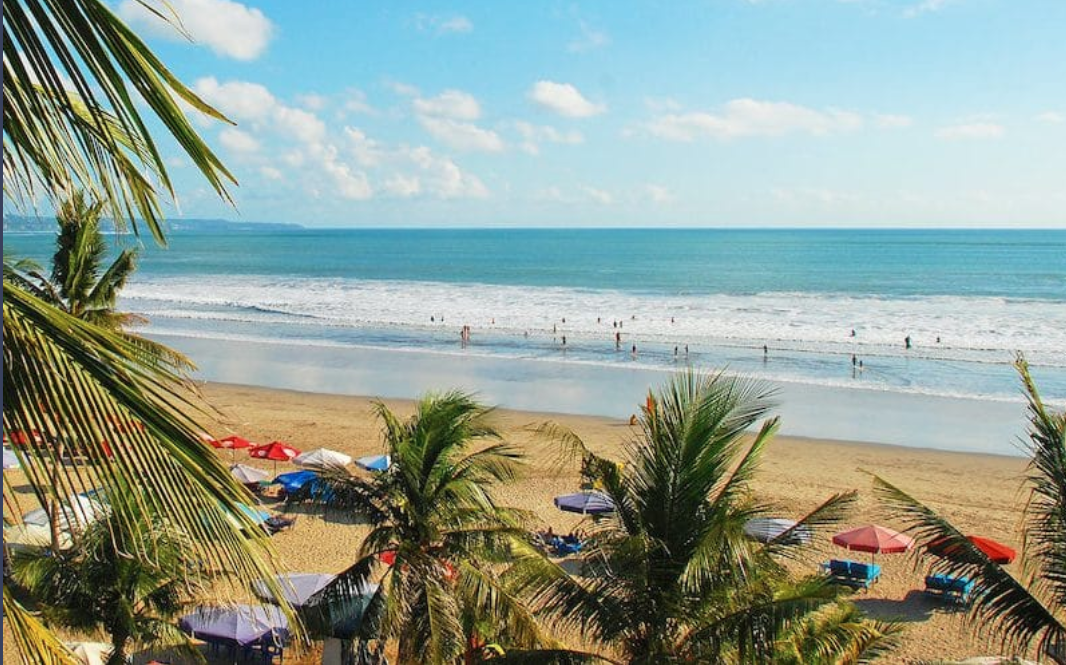
Seminyak
Just north of Legian lies Seminyak, Bali’s upscale playground for luxury lovers, fine dining enthusiasts, and boutique shoppers. Starting from Arjuna Street and Double Six Beach, Seminyak stretches northward, offering a much more polished version of Bali's coastal life.
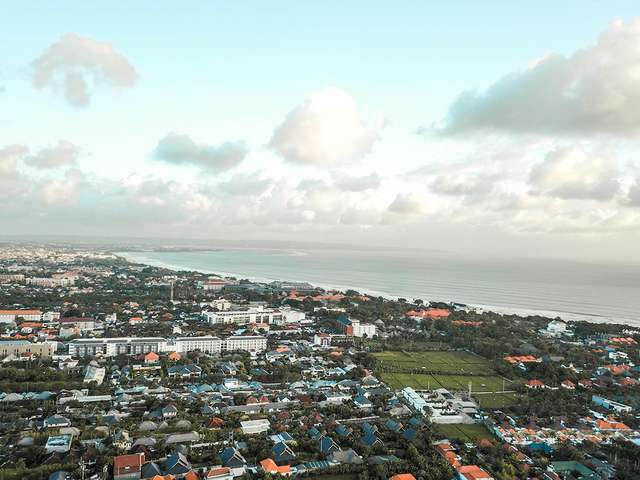
Atmosphere: Seminyak is often seen as the sophisticated alternative to Kuta. You’ll see far fewer tattooed tourists in beer-branded tank tops and far more stylish visitors, trendy cafés, and high-end boutiques.
Accommodation: Seminyak offers a mix of luxury hotels, private villas, and a few mid-range options. Prices here are generally higher than in both Kuta and Legian, though the further you go inland from the beach, the more affordable it becomes. Recommended hotels include The Legian Bali, The Oberoi Beach Resort, and Hotel Indigo Bali Seminyak Beach.
Transport: You can easily walk around Seminyak, although evening traffic jams are common around popular areas like The Oberoi. Online taxis are allowed almost everywhere, but finding a quick pickup can be difficult during busy hours.
Sights and Entertainment: Seminyak is a magnet for high-end dining, beach clubs, spas, and shopping.
Some of the top beach clubs include:
- Potato Head — known for its distinctive shuttered architecture.
- Ku De Ta — famous for both its sunset cocktails and gourmet dining.
- Double Six Rooftop — offering sweeping ocean views over its terraced pools.
- Mrs Sippy — a laid-back pool club with 1m, 3m, and 5m diving platforms (no ocean view, but a great vibe).
Beach: The sand here has a darker, more volcanic quality compared to the lighter beaches further south.If you prefer white-sand beaches, you might find Double Six Beach a little underwhelming.
Pros:
- Walkable area with many amenities nearby
- Huge selection of boutiques, cafés, spas, and clubs
- Stylish and cosmopolitan vibe
Cons:
- High accommodation prices
- Heavy traffic and dense development
Who It’s Recommended For: Perfect for party-goers, fine dining lovers, boutique shoppers, and those who want to be close to nightlife but aren’t necessarily focused on swimming beaches.

Kerobokan
Kerobokan is located just north of Seminyak, beginning behind Kayu Aya Street (often called Oberoi Street). Although many tourists still refer to this area as part of Seminyak, Kerobokan has its own identity.
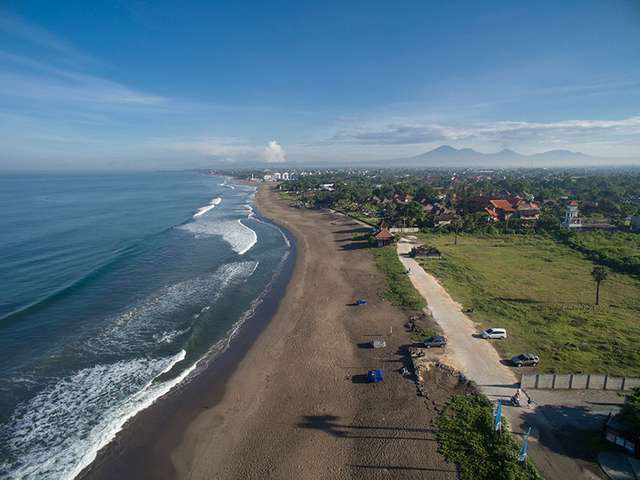
Atmosphere: Kerobokan retains the luxury of Seminyak but offers more space and greenery. Rice fields occasionally peek between villas and restaurants, especially as you move further north. The area feels less dense, with a mix of stylish spots and more traditional Balinese life. Umalas, a sub-district within Kerobokan, is especially notable for its lush greenery and quiet villa complexes, popular among expats.
Accommodation: A mix of boutique hotels, villas, and guesthouses. Accommodation prices are generally more affordable than in Seminyak.
Transport: Walking is convenient in the southern part of Kerobokan. Further north, distances grow, and a motorbike or car is recommended. Online taxis operate almost everywhere.
Beach: The local beaches here have darker sand and are not popular for swimming. These are better suited for casual sunset walks rather than beach days.
Pros:
- More open space and greenery
- Walkable in the south
- More affordable accommodation compared to Seminyak
Cons:
- Beaches are not ideal for swimming
- Sand color is darker and less attractive
Who It’s Recommended For: Long-term residents or visitors seeking a quieter environment between the bustle of Seminyak and the trendiness of Canggu.
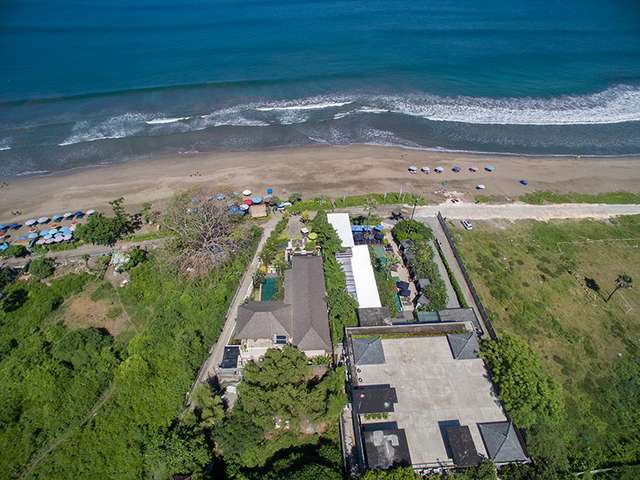
Canggu, Tibubeneng, and Pererenan
These adjacent neighborhoods, often collectively referred to as Canggu, form Bali’s trendy, ever-evolving hub for creatives, surfers, and digital nomads.
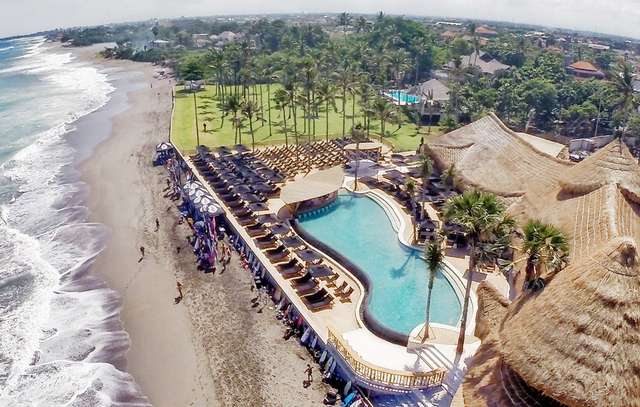
Atmosphere: Canggu has a relaxed, hipster spirit filled with creative energy. Expect colorful murals, whimsical cafes, bustling organic markets, and lots of lush rice fields interwoven between villas and surf shacks.
Accommodation: You’ll find few large hotels here — accommodation mainly consists of stylish villas, eco-resorts, and boutique guesthouses. Prices are generally 20–30% higher than similar places in southern Bali due to the area's popularity.
Transport: Some parts like Batu Bolong, Pandang Linjong, and Berawa are walkable. However, scooters are essential if you stay outside the core areas. Parking can be difficult due to the area's rapid growth.
Sights and Entertainment: Canggu is alive with concerts, markets, yoga sessions, and creative workshops. Popular yoga studios include Samadi, The Practice, and Desa Seni.
Beach: Beaches like Berawa, Batu Bolong, and Pererenan are excellent for surfing but not ideal for swimming. The sand is grayish, and during the rainy season, trash can accumulate.
Pros:
- Colorful graffiti and creative design everywhere
- Wide variety of cafes, bars, restaurants, and organic markets
- Strong surfing culture
- Active nightlife with bars and small clubs
- Lush rice field scenery
- Thriving yoga and wellness community
Cons:
- Beaches have gray sand and rough surf
- Traffic congestion, especially on Raya Canggu
- Limited sidewalks in many areas
Who It’s Recommended For: Young people, creatives, surfers, freelancers, yoga lovers, and anyone drawn to a lively, unconventional lifestyle.
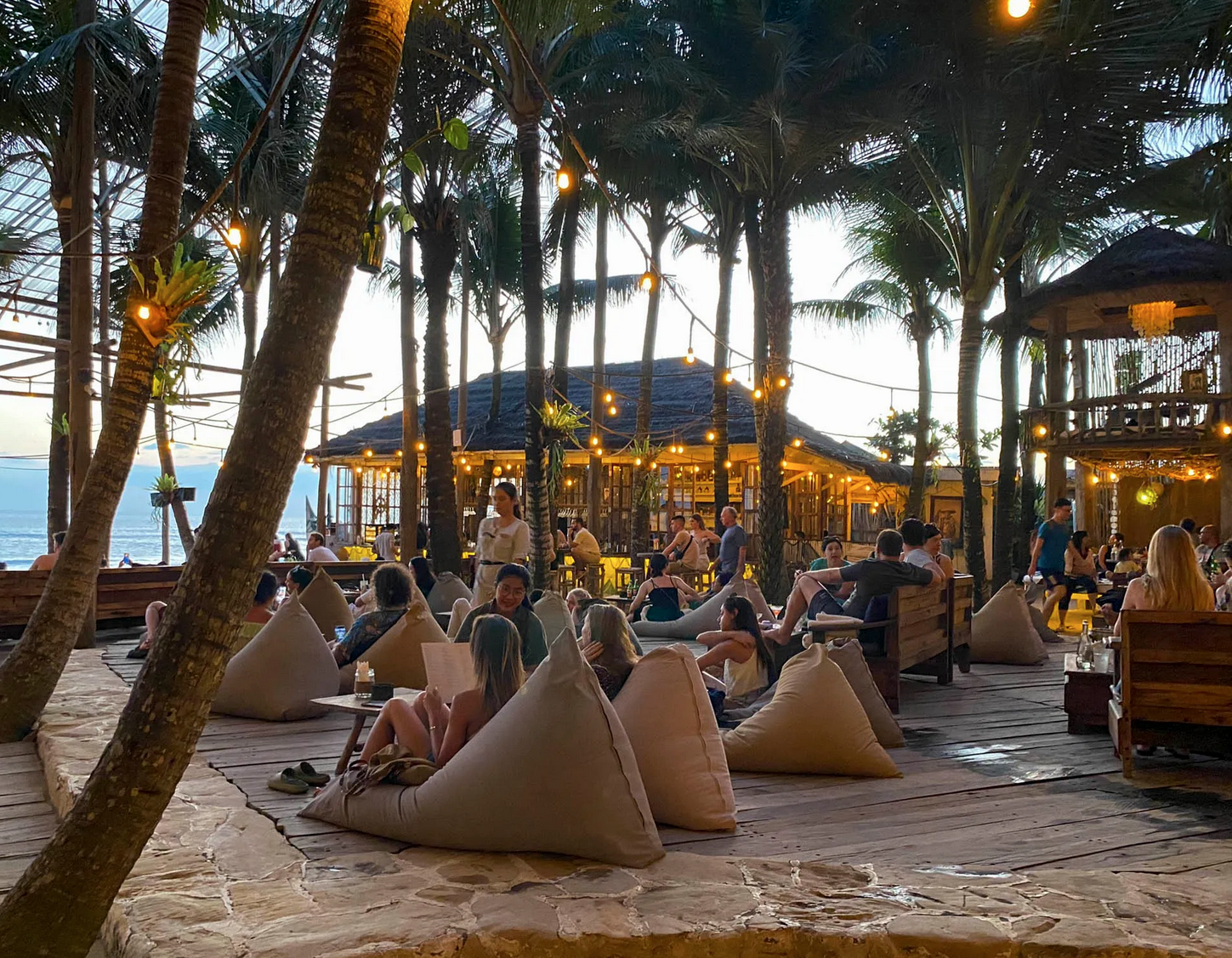
Sanur
Sanur is a laid-back seaside town located on Bali’s east coast, known for its calm beaches, good infrastructure, and peaceful vibe.
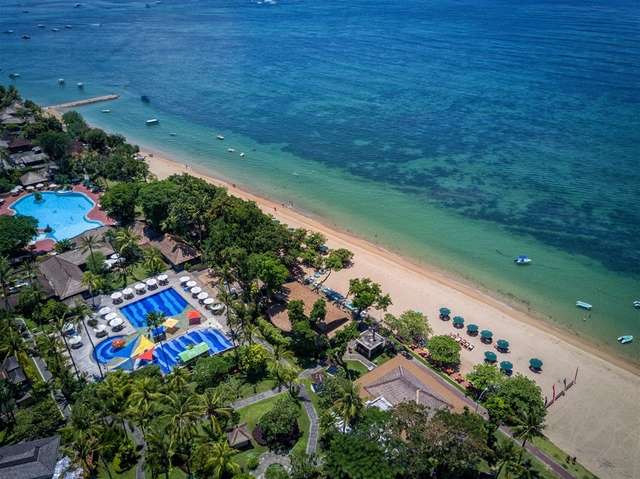
Atmosphere: Sanur offers a quiet, relaxed lifestyle perfect for families, retirees, and long-term travelers. You’ll find paved streets, sidewalks, plenty of shops, and cycle-friendly promenades along the beach.
Accommodation: Sanur offers a mix of affordable guesthouses and mid-range hotels — typically cheaper than Nusa Dua resorts, but still comfortable and family-friendly.
Transport: Walking and cycling are popular. Cars are restricted from the beachfront promenade, and bicycles are a common sight.
Sights and Entertainment: Sanur offers acoustic bars, casual restaurants, and frequent dive trips to Nusa Penida. Nightlife is limited, but the town is lively enough for relaxed evenings.
Beach: Calm waters protected by a reef make Sanur’s beaches perfect for children. The sand can be coarse in places, with coral and occasional seaweed patches.
Pros:
- Very quiet and peaceful
- Good infrastructure and sidewalks
- Safe beaches without big waves
- Popular for cycling and family activities
Cons:
- Sand quality varies; coral and seaweed common
- Limited nightlife
- Tides can expose less appealing beach conditions
Who It’s Recommended For: Families with children, retirees, and travelers seeking a quiet, affordable long-term stay.
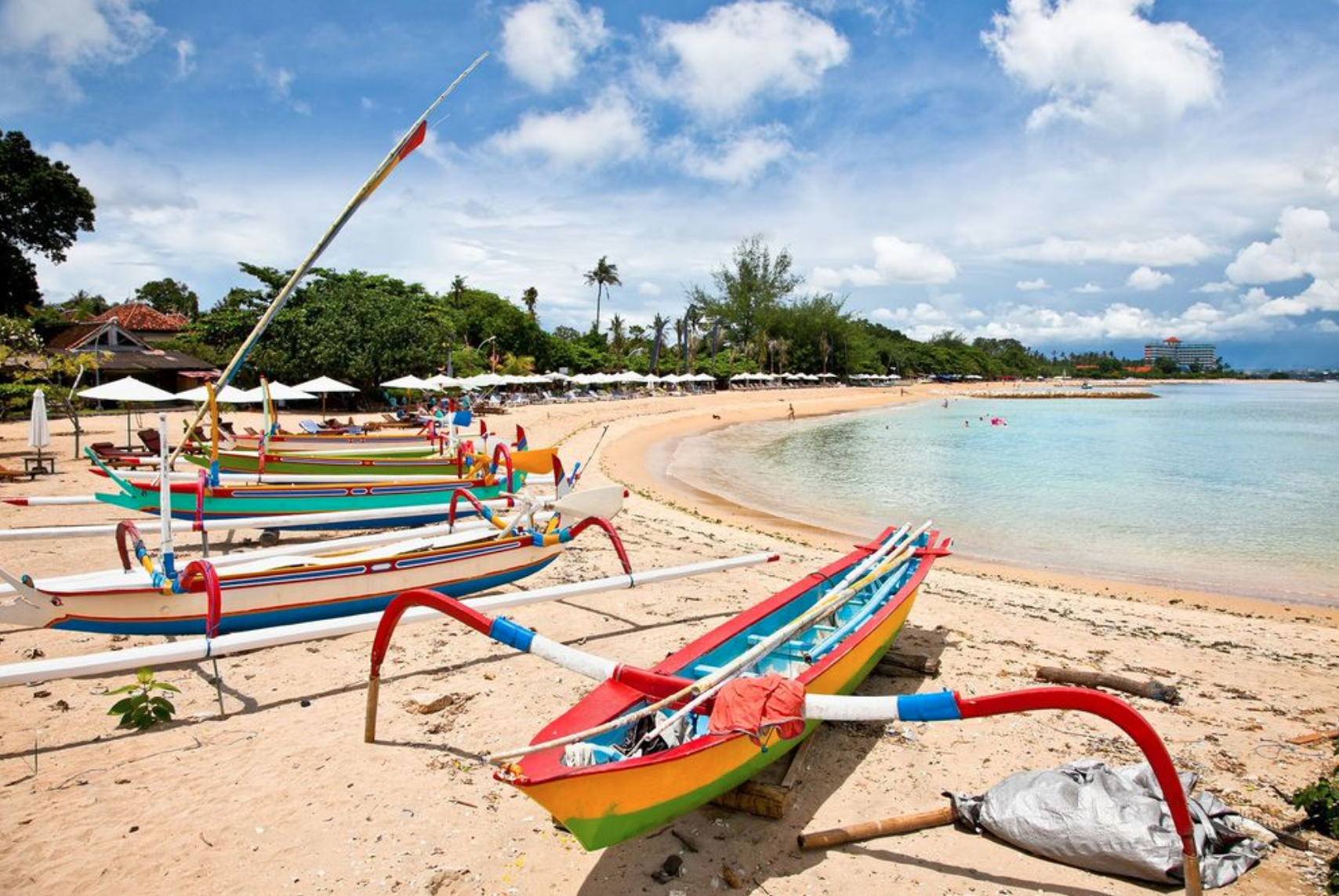
Jimbaran
South of the Bali airport lies Jimbaran, a familiar name for many visitors. It starts in the lowlands and gradually climbs towards the Bukit Peninsula, encompassing both Jimbaran Beach and Balangan Beach.
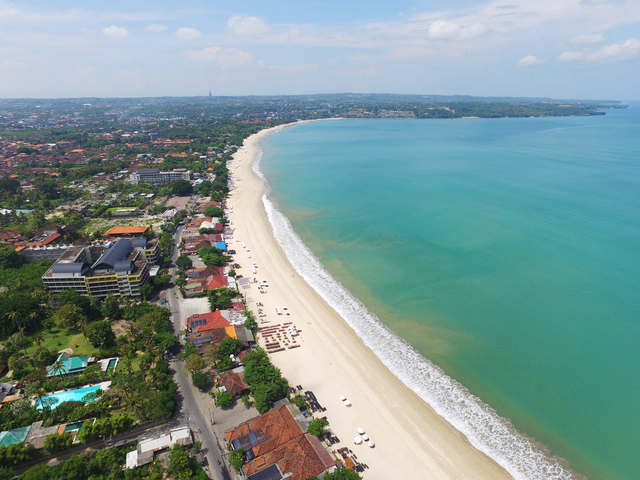
Accommodation: Jimbaran offers a wide range of housing, from budget-friendly guesthouses to luxury cliffside villas and upscale hotels.
Transport: Renting a motorbike or car is highly recommended. Online taxis are available but might not cover every area, especially up in the hills.
Attractions and Entertainment: Jimbaran is known for its peaceful atmosphere — there are no nightclubs here. Instead, it’s famous for Muaya Beach’s seafood restaurants like Menega Cafe and Lia Cafe, where you can dine right on the sand. If you're looking for nightlife, you'll need to head south to Single Fin in Uluwatu or north to Kuta and Seminyak.
Beaches: Jimbaran Beach is ideal for sunset walks and casual swimming, although waves can stir up the sand, making the water a little murky. Balangan Beach is a stunning surf spot, but swimming can be tricky due to strong waves and rocky areas, especially during low tide.
Pros:
- Wide range of affordable and luxury housing
- Plenty of shops, local markets, and restaurants
- Jimbaran Beach is convenient for relaxing strolls and sunsets
Cons:
- No clubs or vibrant nightlife
- Attractions are spread out, requiring transport
Who It’s Recommended For: Ideal for long-term stays, families, freelancers, and anyone looking for affordable living with access to good beaches and a peaceful, local lifestyle.
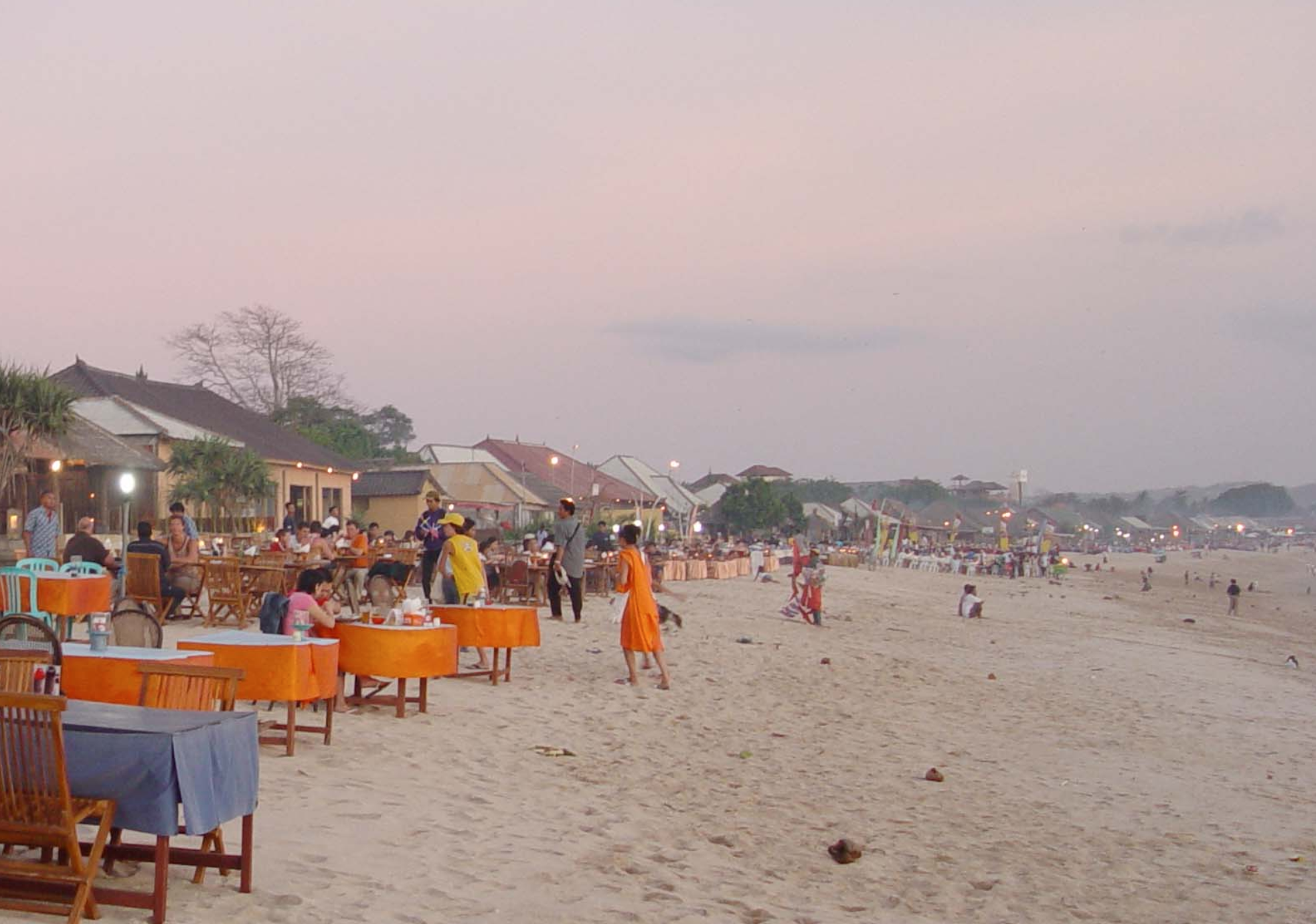
Kedonganan
Kedonganan is a small district located just behind Bali’s Ngurah Rai International Airport. It’s often overlooked by tourists, who usually consider it an extension of Jimbaran, but it has its own distinct local flavor.
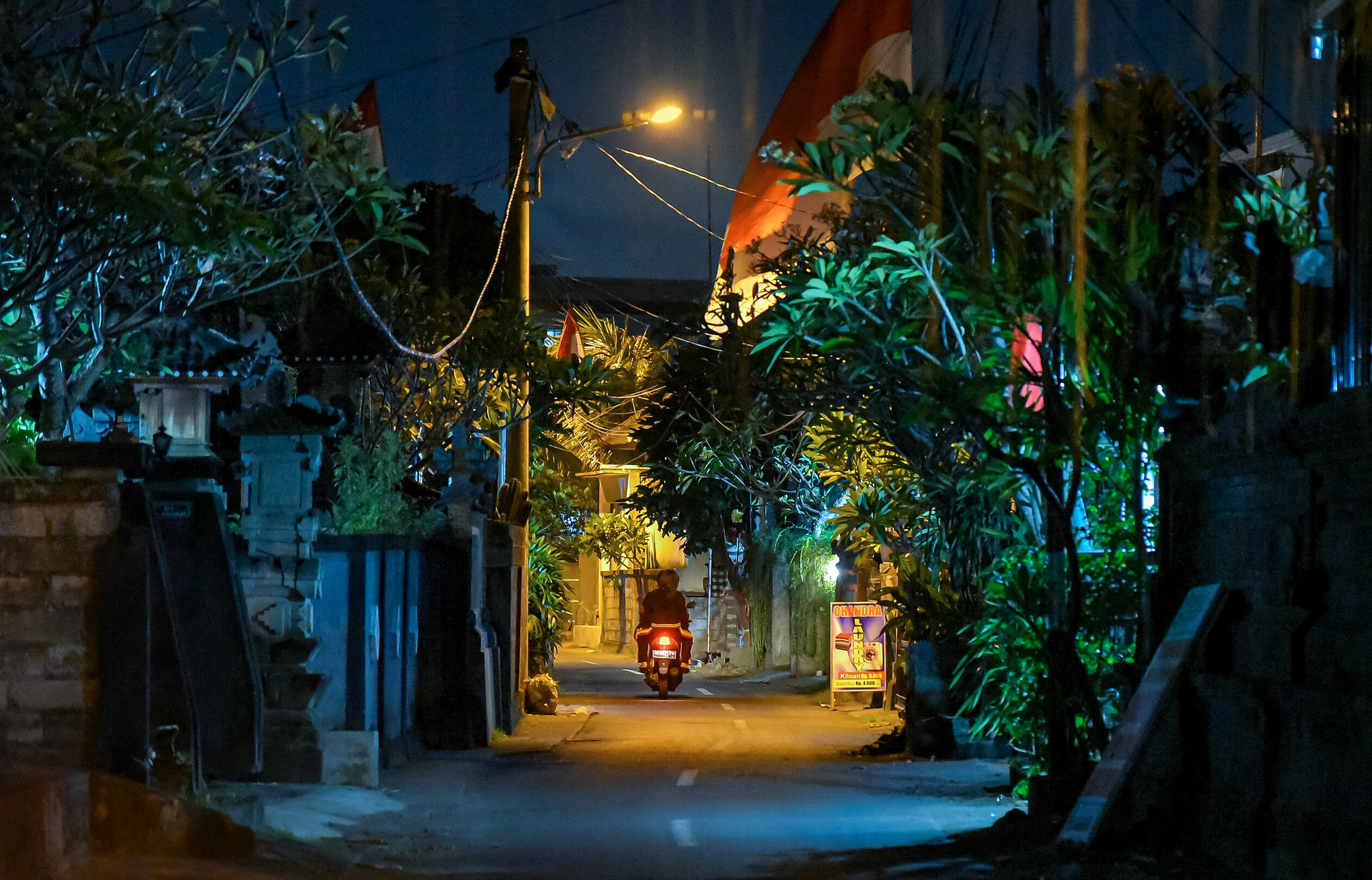
Accommodation: There aren’t many hotels here, but you will find affordable guesthouses and homestays. The area is mostly residential, with a local Balinese population.
Transport: Everything is compactly located, making it easy to walk around without needing a motorbike. However, for longer distances, it’s better to use taxis or rent a scooter.
Attractions and Entertainment: Kedonganan is best known for its vibrant fish market, where you can buy fresh seafood and have it grilled on the spot. Just behind the market, you’ll find the trendy Ibiza in Bali Beach Club, a great spot to relax by the ocean.
Beach: Kedonganan Beach is the northernmost stretch of the long Jimbaran Beach. It’s ideal for morning and sunset walks or runs along the shoreline. While it's not the most picturesque beach in Bali, its authentic local atmosphere offers a unique experience.
Pros:
- Very close to the airport
- Access to fresh seafood at the fish market
- Affordable accommodation options
- Plenty of local shops
Cons:
- Not a particularly scenic or polished setting
Who It’s Recommended For: Travelers who need to stay close to the airport for convenience and don't mind a more local, less touristy atmosphere.
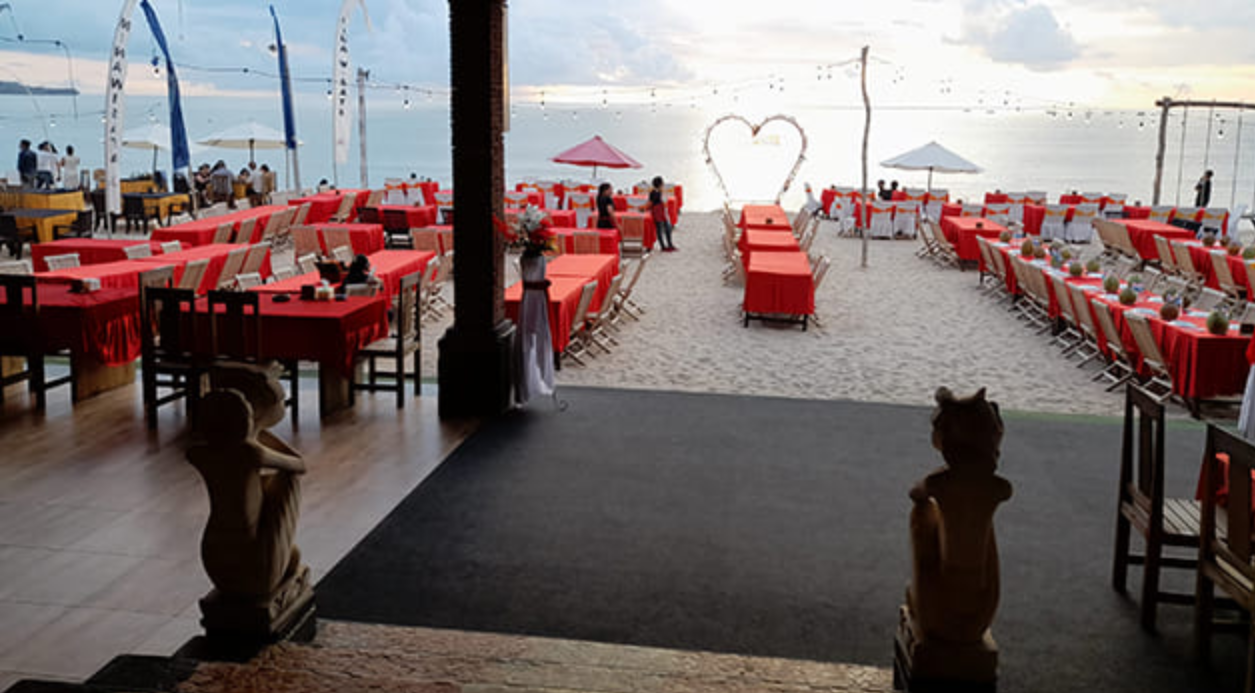
Pecatu, Ungasan, and Kutuh (Uluwatu Area)
Often grouped together under the name Uluwatu, these districts occupy the southern tip of Bali’s Bukit Peninsula and offer some of the island’s most dramatic scenery.
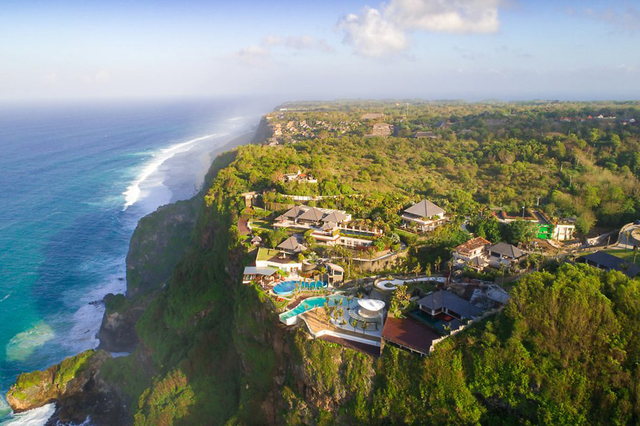
Population: A mix of locals, expats, and tourists.
Accommodation: Options range from luxurious cliffside resorts to affordable guesthouses tucked into local villages.
Transport: Renting your own scooter or car is essential here — online taxis are not allowed in many areas.
Attractions and Entertainment:
- Uluwatu Temple, perched dramatically on a cliff, is a must-visit, especially at sunset.
- GWK Park, featuring the massive Vishnu and Garuda statue, is growing in popularity.
- Cliffside clubs like Savaya, OneEighty, El Kabron, and Ulu Cliffhouse attract the glamorous crowd.
- Single Fin Bar is the go-to for sunset drinks and lively Sunday parties.
Beaches: Stunning white-sand beaches surrounded by cliffs — Melasti, Pandawa, Padang-Padang, Dreamland, Bingin, Suluban, Thomas Beach, and Gunung Payung. Some west coast beaches can accumulate plastic during the rainy season, while south-facing beaches remain cleaner year-round.
Pros:
- Spectacular beaches and surf spots
- Beautiful villas on cliffs
- Less crowded, more natural environment
- Trendy beach clubs with breathtaking views
Cons:
- Few shops and markets
- Transport is a must (walking is often impractical)
- Limited nightlife options outside of cliff clubs
Who It’s Recommended For: Perfect for beach lovers, surfers, and travelers seeking a combination of scenic beauty and relaxed luxury.
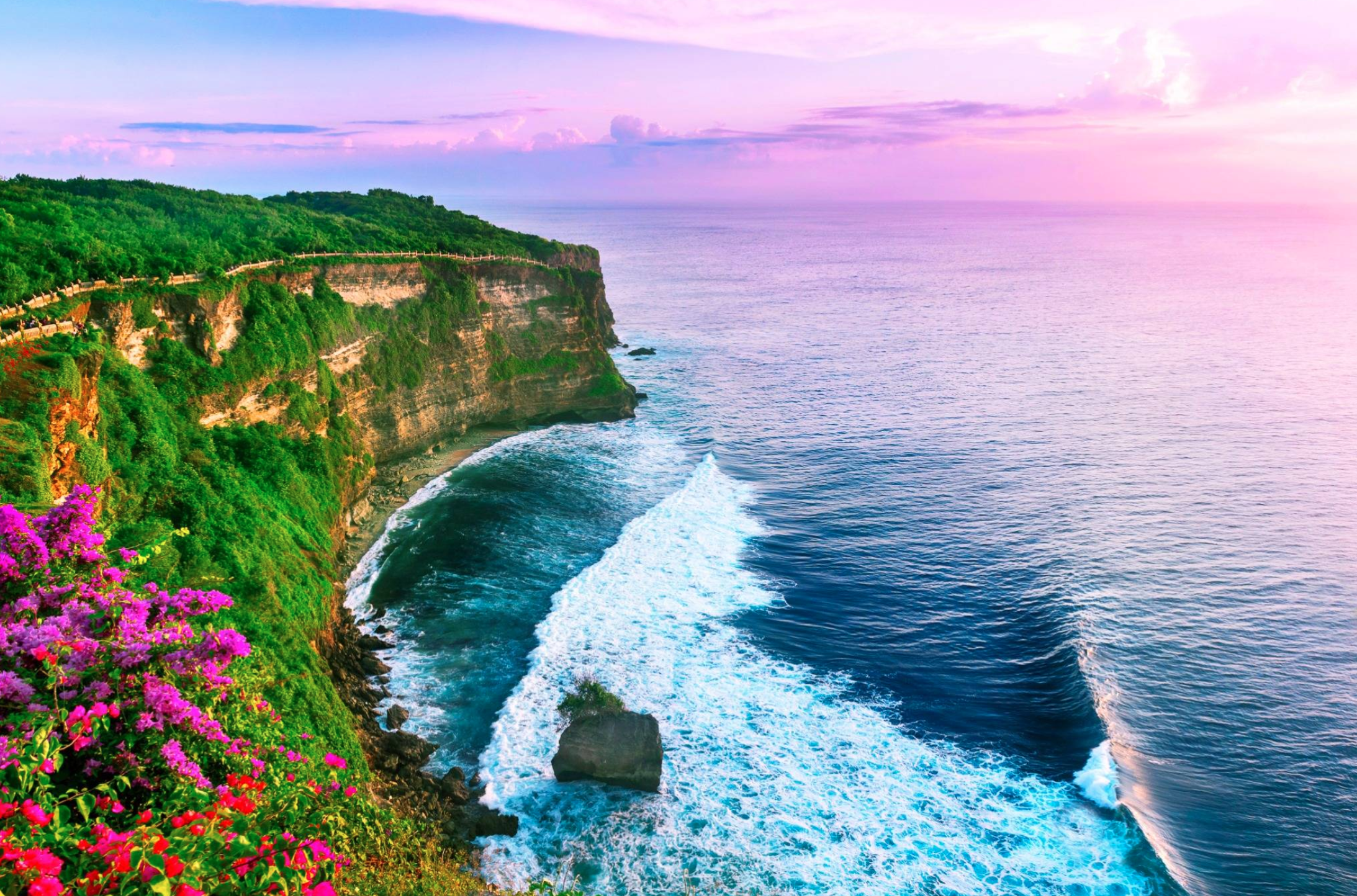
Benoa, Nusa Dua
Benoa and Nusa Dua together form Bali’s elite tourist enclave on the eastern side of the Bukit Peninsula.
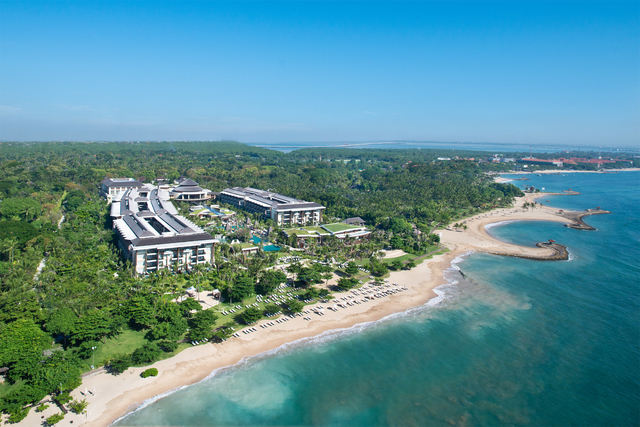
Accommodation: The beachfront is lined with luxury five-star hotels. Further inland, you’ll find affordable guesthouses and long-term rentals.
Transport: Renting your own scooter or car is necessary, as distances between beaches, shops, and restaurants can be significant. Online taxis are restricted in some areas.
Attractions and Entertainment:
- Bali Collection shopping complex for restaurants, spas, and souvenirs.
- Five Temples Square — a unique religious site featuring temples from Indonesia’s five main religions.
- Parks and manicured landscapes perfect for peaceful walks.
Beaches: Nusa Dua boasts beautiful, clean beaches, perfect for swimming, even during the rainy season. Public beaches like Geger and Mengiat are especially recommended. Some sections are shallow during low tide but still very family-friendly.
Pros:
- Stunning, well-kept resort areas
- Clean beaches ideal for families and children
- Quiet, relaxing environment
Cons:
- High prices for food and goods in the tourist zone
- Lack of nightlife (you’ll need to travel for parties)
- Restricted access for online taxis
Who It’s Recommended For: Perfect for families, honeymooners, and anyone wanting a luxurious, hassle-free beach vacation without needing much adventure.
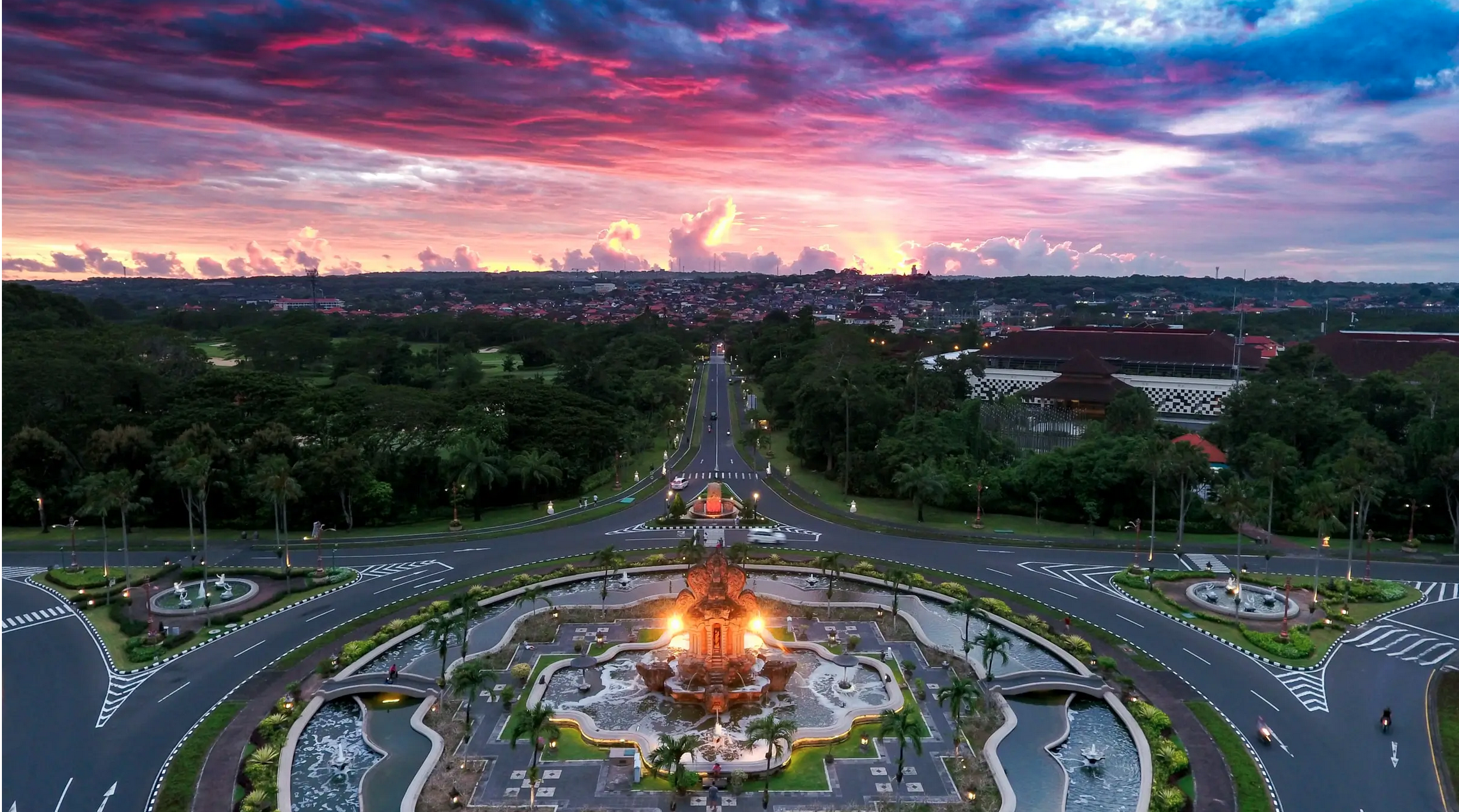
Serangan
Serangan is a small peninsula south of Sanur, known traditionally as a Balinese fishing village and a surfing spot during the rainy season.
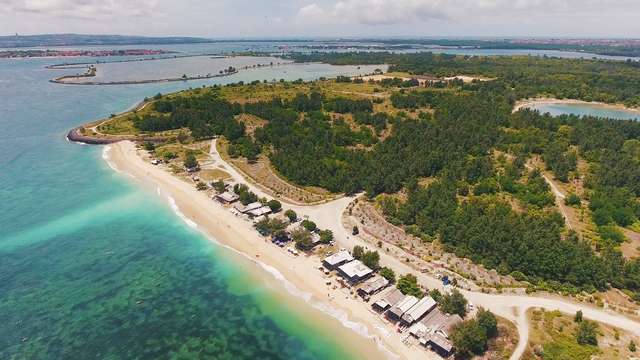
Atmosphere: Serangan today is in transition — land has been cleared for future development, and a major eco-resort project is underway. For now, the area remains largely undeveloped and local.
Accommodation: There is currently no tourist accommodation available on Serangan.
Transport: Private transport is necessary if visiting. There’s little infrastructure for tourists.
Beach: Previously a popular rainy-season surf beach, surfing here is currently limited or inactive.
Pros:
- Quiet and authentic local atmosphere
Cons:
- No tourist infrastructure
- Surfing and accommodation options are currently unavailable
Who It’s Recommended For: At this stage, Serangan is more of a watch-this-space area for future development rather than a destination for travelers.
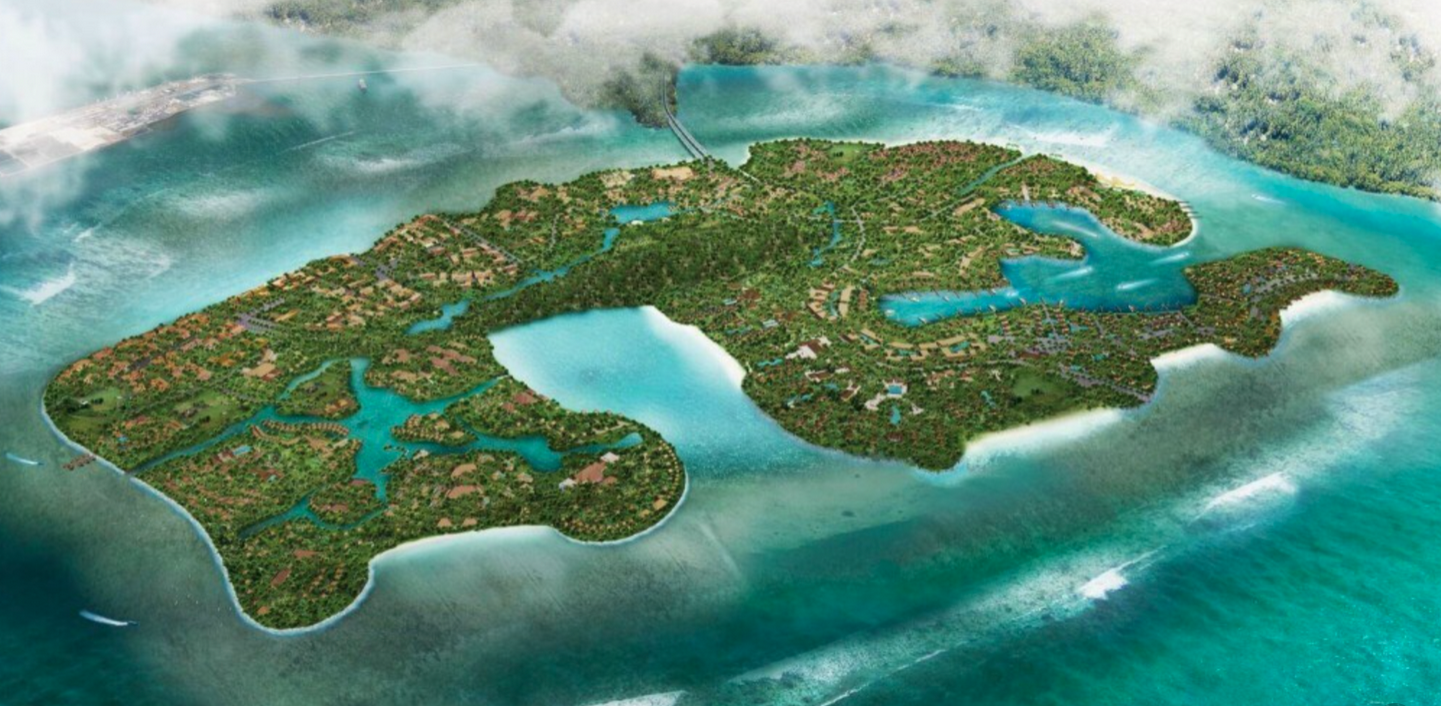
Central Bali: Spirituality, Culture, and Jungle Views
Leaving the coast behind, Central Bali invites you into its lush green heart. Here, life moves more slowly among rice fields, temples, art galleries, and jungle landscapes. This is the cultural and spiritual soul of Bali, ideal for those seeking inspiration, healing, and beauty.
Ubud
Ubud is Bali’s cultural and spiritual capital, located inland among rice fields and tropical jungles.
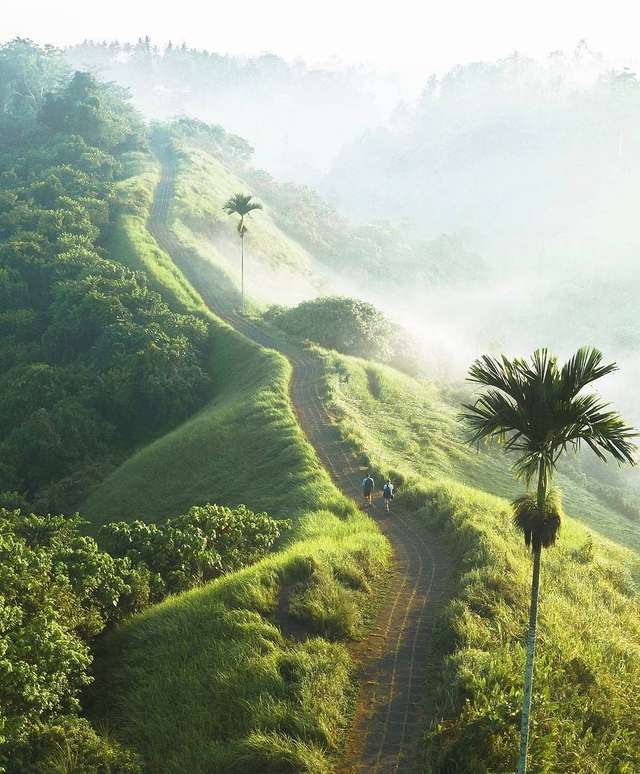
Atmosphere: Ubud blends traditional Balinese culture, art, and wellness into a unique town filled with temples, art galleries, yoga studios, and vegan cafés.
Accommodation: Options range from luxury jungle resorts and five-star retreats to affordable boutique guesthouses.
Transport: Walking is easy in the town center, but for visiting surrounding sights, a motorbike or driver is needed.
Sights and Entertainment: Highlights include Ubud Palace, Monkey Forest, Tegalalang Rice Terraces, Campuhan Ridge Walk, Tirta Empul holy spring, and excursions to Mount Batur.
Beach: Ubud is inland — the nearest beaches (such as Bias Tugel or Virgin Beach) are about 1.5–2 hours away.
Pros:
- Beautiful jungle landscapes
- Cooler climate
- Rich cultural life with art, yoga, and meditation
- Great restaurants and healthy cafés
Cons:
- Far from beaches
- High humidity
- No nightlife scene
Who It’s Recommended For: Yoga and meditation enthusiasts, cultural travelers, long-term visitors seeking peace, creativity, and nature.
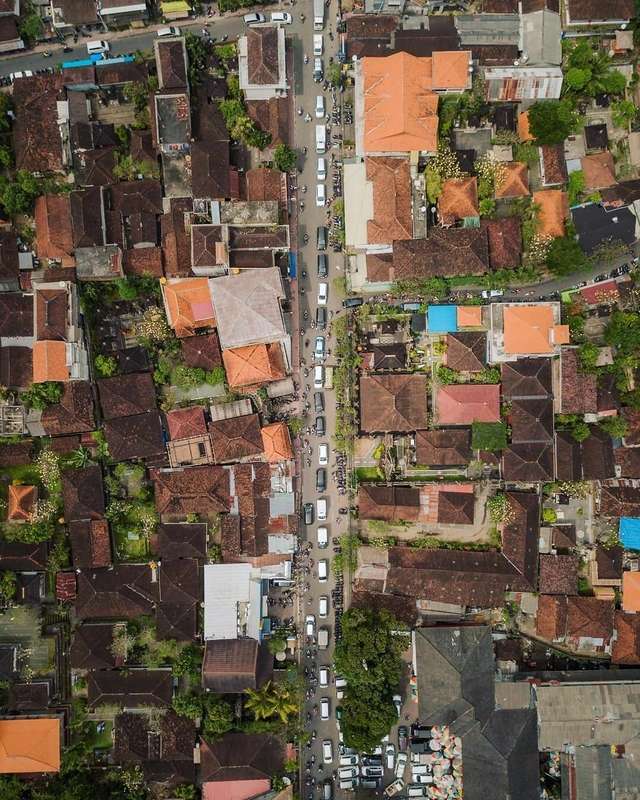
Gianyar (Outside Ubud)
Gianyar regency surrounds Ubud and includes Bali’s most famous artisan villages.
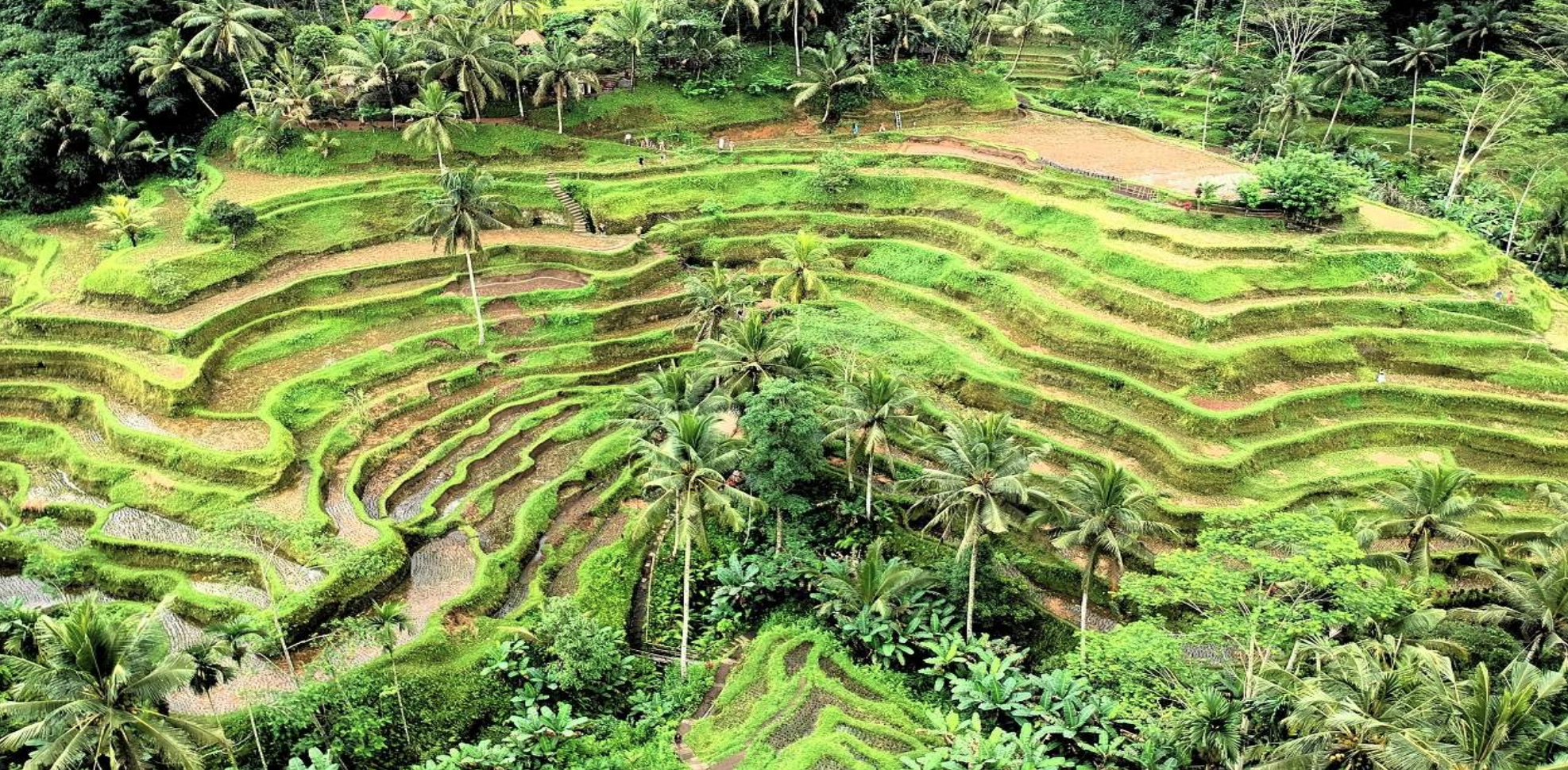
Atmosphere: Rural, traditional, and culturally rich. The heart of Bali’s artistic traditions..
Accommodation: Scattered guesthouses, villas, and homestays.
Transport: Private vehicle or hired driver recommended.
Sights and Entertainment:
- Batubulan Village (stone carving).
- Celuk Village (silver jewelry).
- Mas Village (wood carving).
- Traditional Balinese dance performances in temples and theaters.
Beaches: Gianyar’s southern coastline has several wild, black-sand beaches, including Keramas, Saba, and Pantai Purnama. While these beaches are less developed and not ideal for swimming, they are popular for surfing, sunrise walks, and horseback riding along the shore.
Pros:
- Authentic Balinese culture and art
- Close to Ubud
Cons:
- Limited tourist infrastructure outside Ubud itself
Who It’s Recommended For: Travelers interested in art, crafts, and traditional Balinese performances.
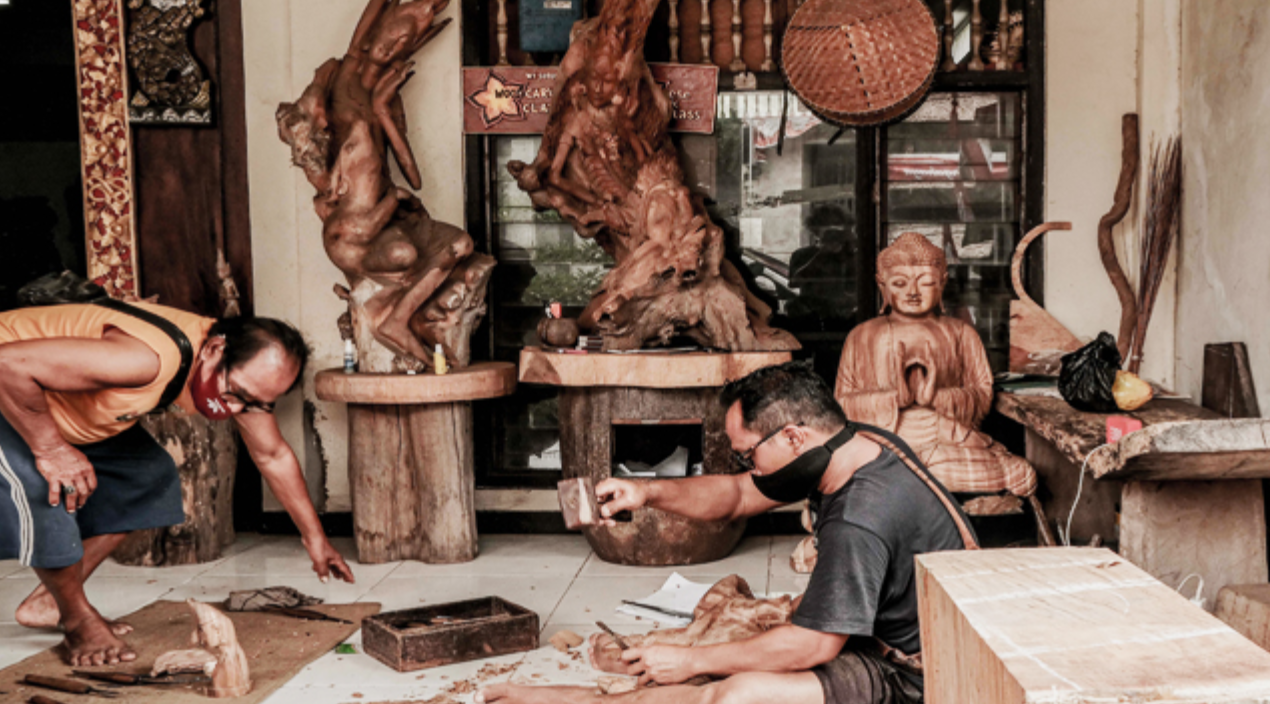
Denpasar
Denpasar is the capital city of Bali, located inland between the southern beach towns and central Bali. It’s a densely populated area, mostly inhabited by locals, with a strong Balinese and Indonesian cultural presence.
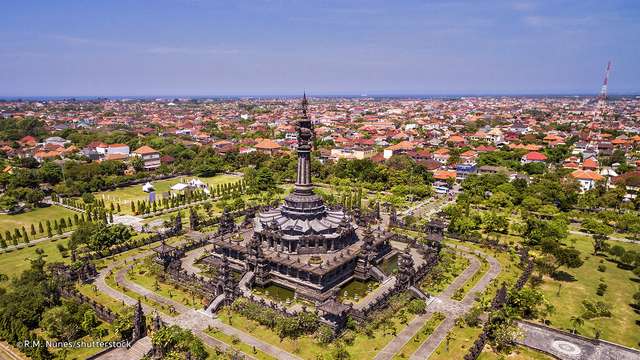
Atmosphere: Denpasar feels very much like a true Indonesian city — busy, local, and authentic. It’s not designed for tourists, and while there are some hotels, they mostly cater to domestic visitors or budget travelers.
Accommodation: If proximity to the ocean and European-style infrastructure isn’t a priority, you can find affordable, good-quality apartments here. It’s one of the cheaper areas for long-term living.
Transport: A motorbike or car is necessary to get around. Online taxis are widely available in most parts of Denpasar.
Sights and Entertainment: The Renon district offers spacious parks, embassies, and administrative centers. The central park road is closed to cars on Sundays, becoming a pedestrian paradise for walking, running, or cycling. The Kumbasari Market is a popular spot to buy local souvenirs, fruits, and vegetables at great prices.
Beaches: Denpasar isn’t on the coast, but nearby beaches such as Sanur, Kuta, Legian, Seminyak, Berawa, and Canggu are accessible with a short drive.
Pros:
- Affordable apartments
- Authentic local flavor
- Large parks for recreation
Cons:
- High population density
- Air pollution from traffic
- Limited tourist infrastructure
Who It’s Recommended For: Expats or long-term residents on a tight budget who are ready to fully immerse themselves in local Balinese urban life.
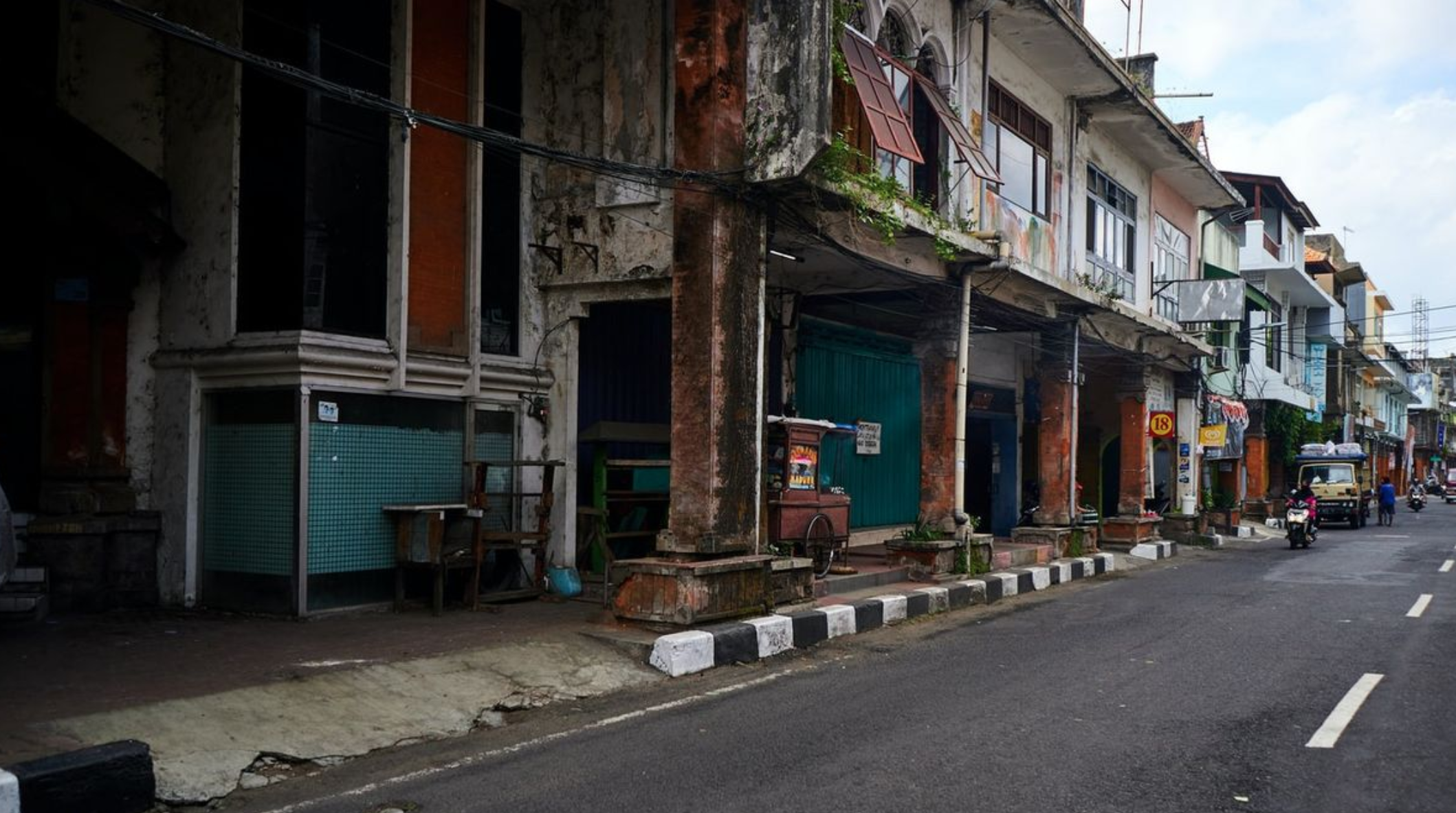
North Bali: Calm Coastal Towns and Waterfalls
North Bali feels like a world away from the south’s energy. Here, peaceful beaches, cool mountain air, and stunning waterfalls offer a slower, more authentic side of the island. It's perfect for travelers looking to unwind and explore nature at a gentler pace.
Lovina
Lovina is a peaceful resort area located on the north coast of Bali, slightly west of the city of Singaraja — the administrative capital of North Bali.
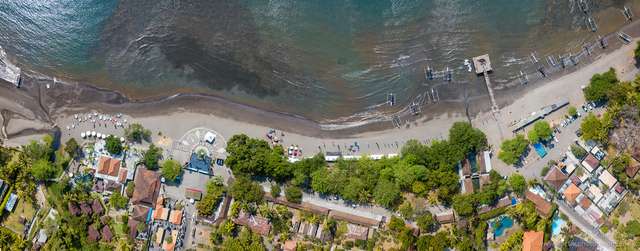
Atmosphere: Lovina offers a quiet, slow-paced environment with far fewer tourists than the southern regions. It's ideal for travelers looking to explore Bali’s natural wonders without the hustle and bustle. The area stretches along the coastal highway, with small villages and resorts spread out along the beach.
Accommodation: While there are no five-star resorts, you’ll find a selection of mid-range hotels, budget guesthouses, and private villas. Prices tend to be higher than similar accommodations in the south due to lower competition.
Transport: A motorbike or car rental is necessary to explore Lovina and surrounding attractions. Walking is feasible within village centers, but distances can be long.
Sights and Entertainment:
- Waterfalls: Visit Sekumpul, Aling-Aling, Gitgit, Jembong, and Munduk waterfalls.
- Mountain Lakes: Explore the beautiful trio of Lake Bratan, Lake Buyan, and Lake Tamblingan.
- Temples: The Vihara Brahma Arama Buddhist monastery and Vihara Dharma Giri temple.
- Dolphin Watching: Early morning dolphin tours are popular, though sightings are less reliable now due to the noise of the boats.
- Evenings: Some restaurants and bars host live acoustic concerts, but there’s no clubbing scene.
Beaches: Lovina Beach is lined with dark pebbles, offering calm waters suitable for safe swimming, although it’s not a classic "tropical postcard" beach.
Pros:
- Quiet and relaxing atmosphere
- Access to Bali’s best waterfalls
- Calm, swimmable beach
Cons:
- Pebble beach, not fine sand
- Limited dining and nightlife options
- Higher accommodation prices for the quality
Who It’s Recommended For: Travelers looking for a peaceful base to explore northern Bali, waterfall seekers, and those who want to experience Bali away from the crowds.
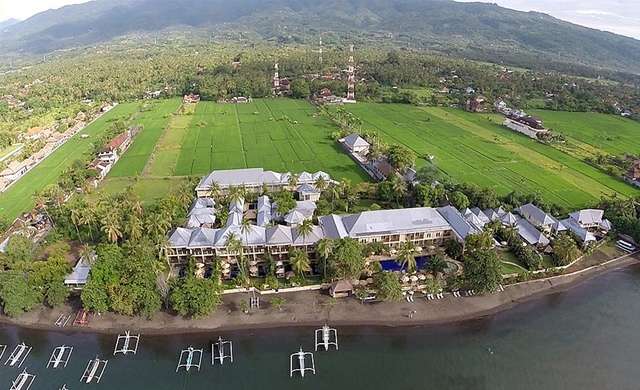
Singaraja
Singaraja is the second-largest city in Bali, located on the north coast, east of Lovina.
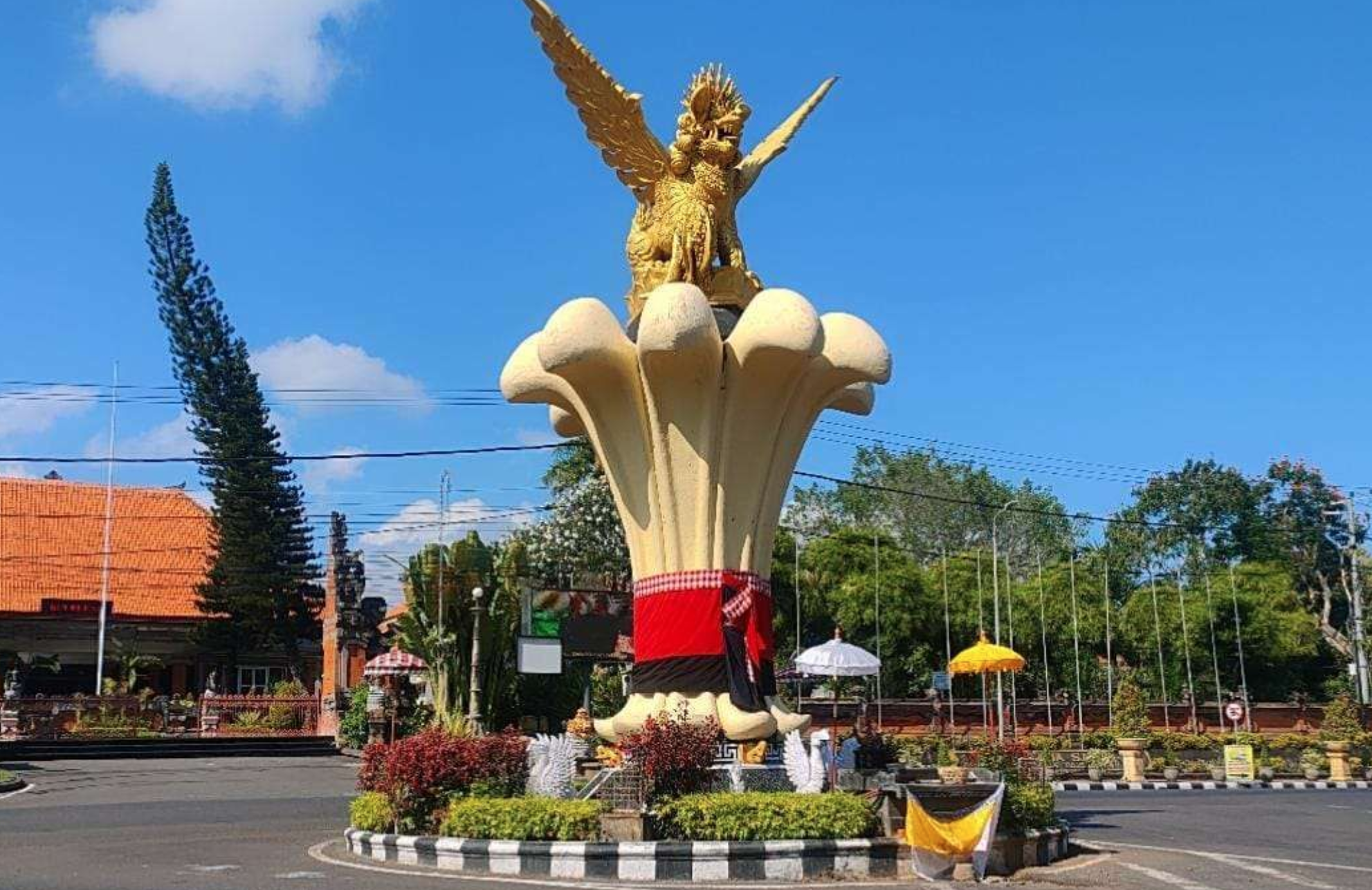
Atmosphere: Singaraja is a bustling local city, formerly the Dutch colonial capital of Bali and Lombok. It feels authentic and non-touristy, offering a glimpse into daily Balinese urban life without major tourist attractions.
Accommodation: Minimal tourist infrastructure. Mainly local hotels and simple guesthouses.
Transport: A motorbike or car is essential. Online taxis are available.
Sights and Entertainment:
- Gedong Kirtya Library, home to historical lontar manuscripts.
- Local markets and temples.
- Close to Lovina and North Bali’s natural attractions.
Beaches: Black sand beaches nearby, but not a primary beach destination.
Pros:
- Authentic Balinese city life
- Convenient base for North Bali exploration
Cons:
- No major tourist infrastructure
- Limited entertainment and nightlife
Who It’s Recommended For: Long-term expats, adventurous travelers wanting to explore Bali’s local life.
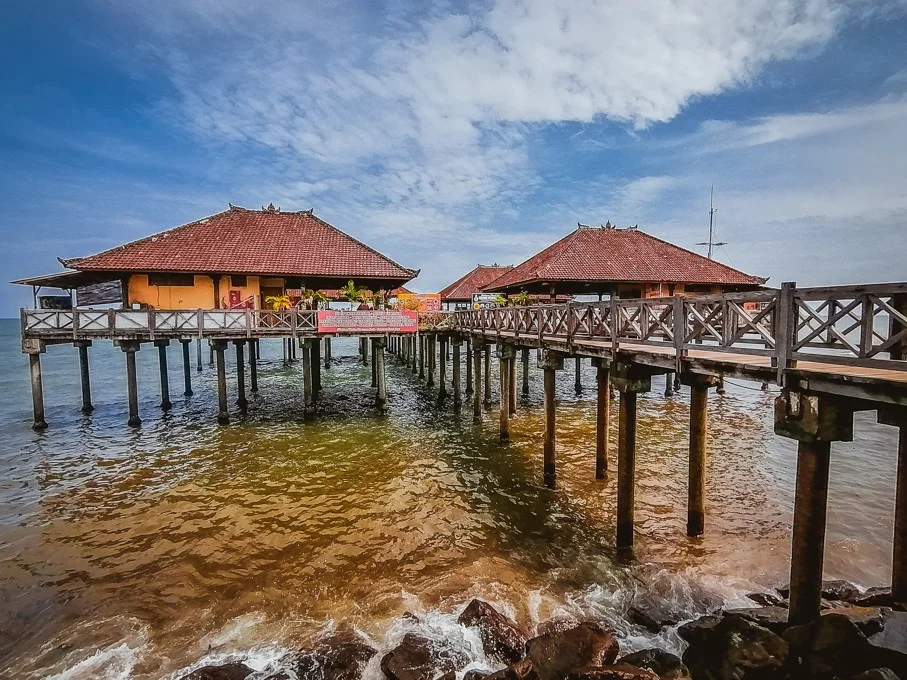
Kintamani
Kintamani is a highland region surrounding the majestic caldera of Mount Batur in central Bali.

Atmosphere: The area has a cooler climate and is primarily rural, inhabited by locals. Tourists mainly visit for a few hours to admire the stunning views of Mount Batur and Lake Batur, climb the volcano at sunrise, or soak in the natural hot springs.
Accommodation: There are few quality accommodation options. Hotels and restaurants mainly focus on views rather than service.
Transport: Private transport is essential to visit and explore. No significant public transport or regular online taxis are available.
Sights and Entertainment:
- Mount Batur Sunrise Trekking.
- Hot Springs of Toya Devasya and other resorts.
- Scenic cafés overlooking the caldera.
Beaches: Kintamani is located inland — beaches are hours away.
Pros:
- Spectacular natural beauty
- Cool mountain climate
- Unique volcanic landscapes
Cons:
- Limited quality of accommodation and dining
- Primarily a day-trip destination, not suitable for long stays
Who It’s Recommended For: Adventure seekers wanting to climb Mount Batur, nature lovers, and travelers looking for cooler air and scenic views.
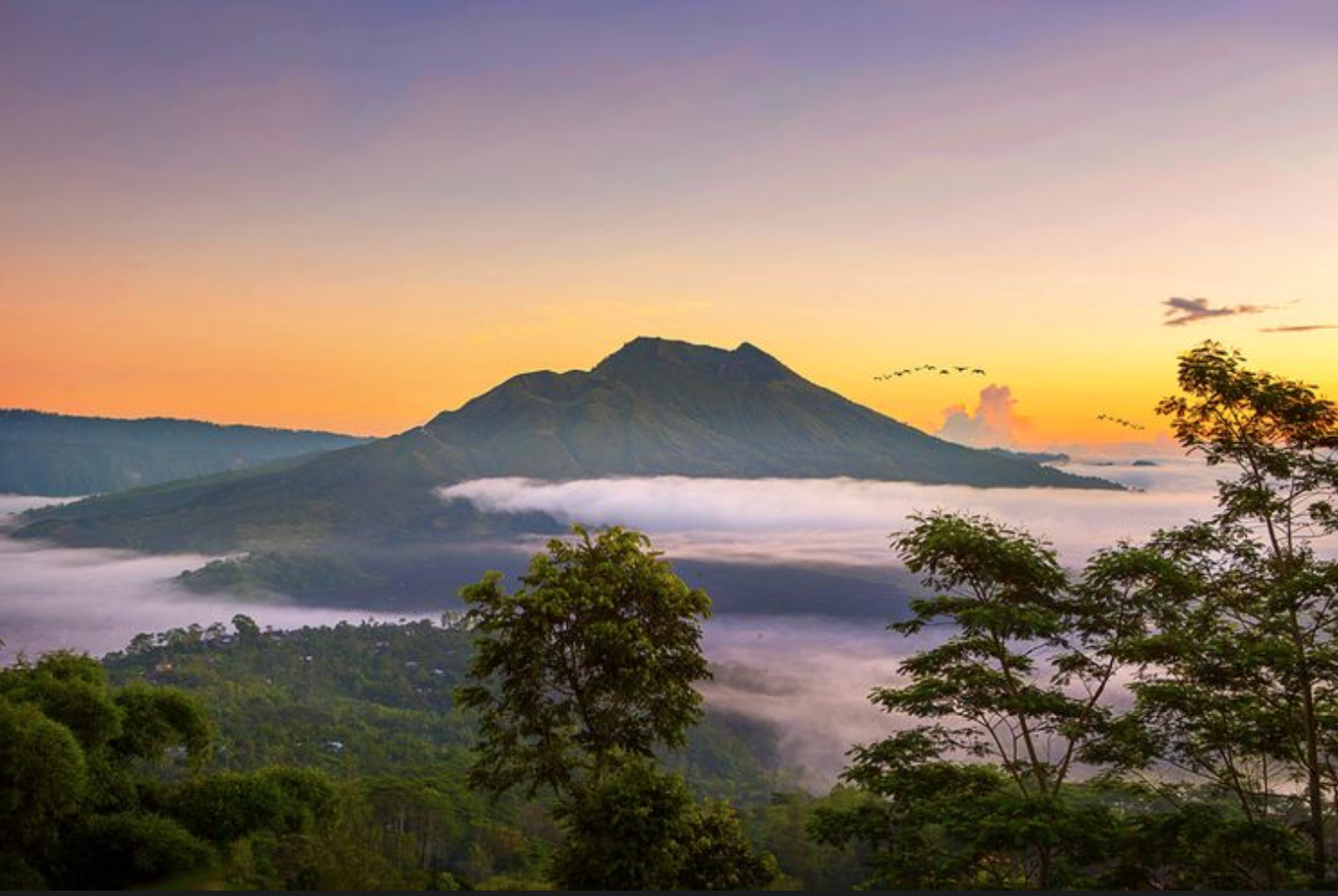
West Bali: Untouched Wilderness and Diving Adventures
West Bali remains largely untouched, offering a rare glimpse into the island’s wild side. If you crave solitude, jungle treks, and world-class diving, this remote region is the perfect escape.
Bali Barat National Park
West Bali is the island’s wild frontier, home to West Bali National Park, Menjangan Island, and vast untouched landscapes.
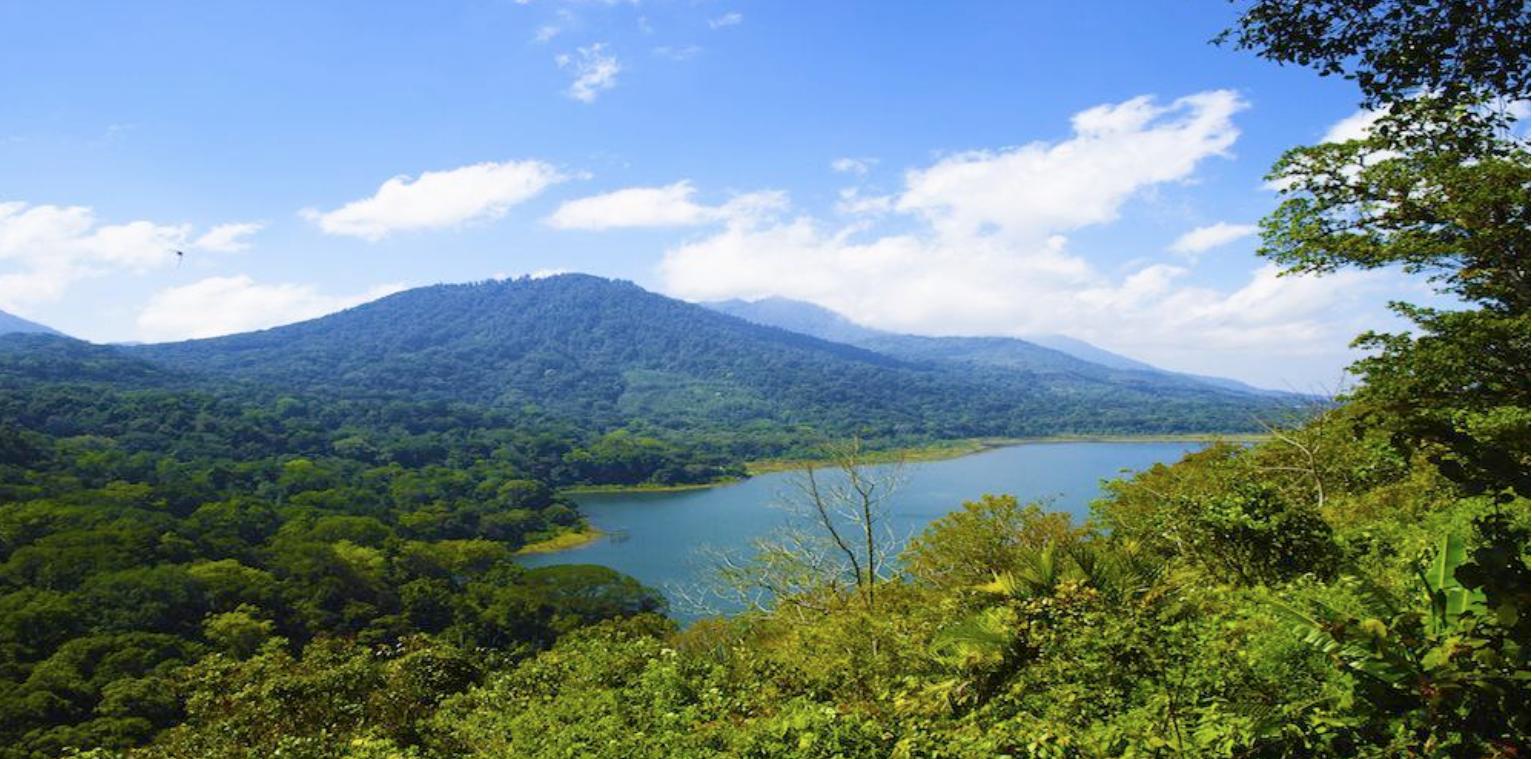
Atmosphere: Very remote, quiet, and natural. Tourism is minimal compared to the south..
Accommodation: Limited to eco-lodges, resorts, and dive centers.
Transport: Private transport is necessary; very little public transport.
Sights and Entertainment:
- Diving and snorkeling at Menjangan Island — some of Bali’s best reefs.
- Jungle trekking and birdwatching in West Bali National Park.
Beaches: Beautiful, isolated beaches around Menjangan, great for snorkeling.
Pros:
- Incredible marine life and diving
- Peaceful, untouched nature
Cons:
- Far from central Bali
- Very limited nightlife and entertainment
Who It’s Recommended For: Nature lovers, divers, and travelers seeking off-the-beaten-path experiences.
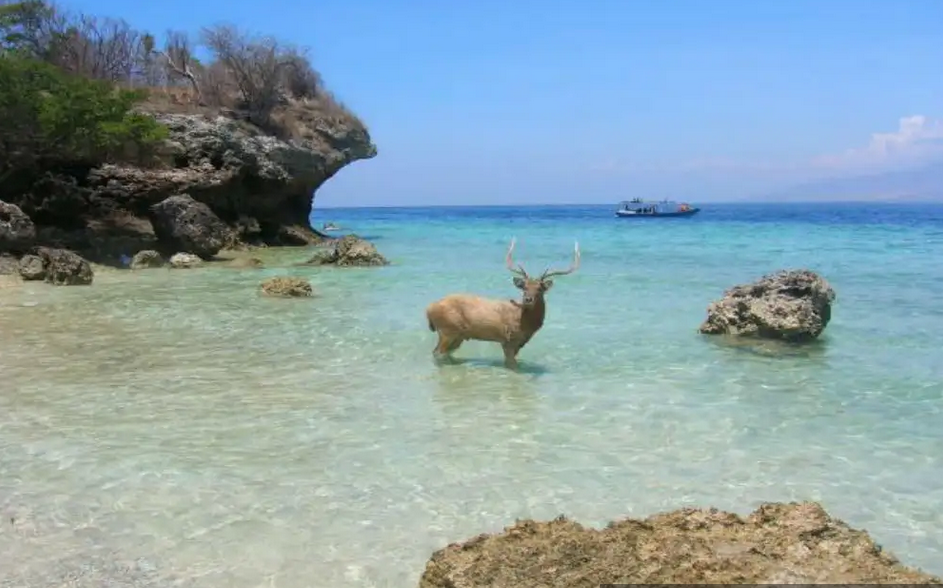
East Bali: Laid-Back Towns and Cultural Gems
East Bali is rich in culture, spirituality, and dramatic landscapes. Ancient temples, peaceful villages, and black-sand beaches make this region a dream for travelers seeking a quieter, more traditional Bali.
Candidasa
Candidasa is a small, quiet coastal town on Bali’s eastern shore.
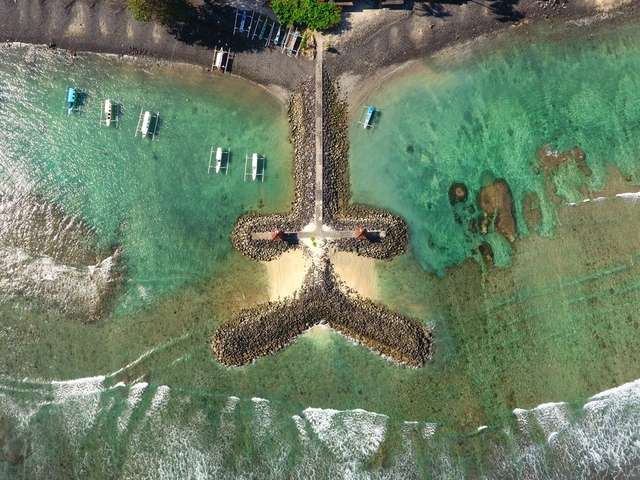
Atmosphere: The town is laid-back and peaceful, appealing to travelers looking to escape the crowds..
Accommodation: Primarily mid-range hotels and a few higher-end resorts. Budget options are limited..
Transport: A car or scooter is necessary to explore surrounding areas and beaches.
Sights and Entertainment: Visit the Lotus Lagoon, or explore the Goa Lawah Bat Cave temple nearby.
Beach: The beach has black volcanic sand and can be rough. However, stunning white-sand beaches like Virgin Beach are a short drive away.
Pros:
- Quiet, authentic Bali atmosphere
- Easy access to natural attractions
Cons:
- Limited hotel and restaurant choices
- Beach not ideal for swimming
- Far from the airport
Who It’s Recommended For: Travelers seeking solitude, nature, and a simple coastal experience away from tourist hotspots.
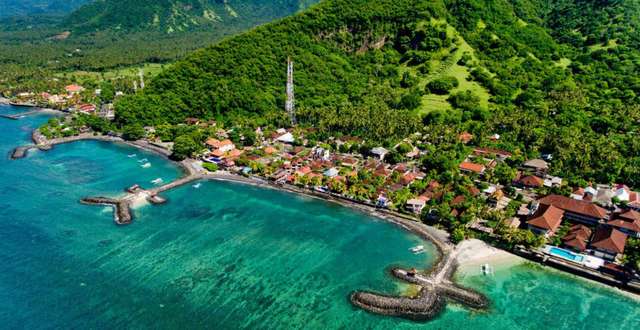
Amed
Amed is a peaceful coastal region in East Bali, known for its diving and freediving culture.
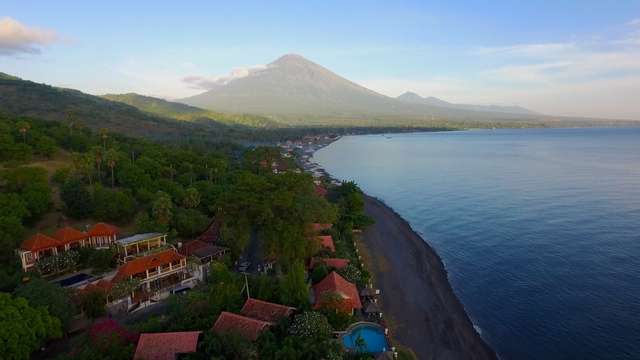
Atmosphere: Amed offers a rural, authentic Balinese experience, with a slow pace of life, local markets, and a stunning view of Mount Agung.
Accommodation: Mostly affordable guesthouses and small hotels, many within walking distance to the beach.
Transport: Walking is possible within villages, but renting a scooter is useful for exploring the area..
Sights and Entertainment: Visit the Tirta Gangga and Taman Ujung water palaces, dive the Liberty shipwreck in Tulamben, and snorkel directly off the beach.
Beach: Beaches are covered in black pebbles, with clear waters excellent for snorkeling and diving.
Pros:
- Affordable accommodation
- Tranquil atmosphere
- Rich diving and snorkeling opportunities
- Authentic rural charm
Cons:
- Pebble beaches, not sandy
- Few shops and restaurants
- Remote location far from the airport
Who It’s Recommended For: Divers, freedivers, and travelers seeking peace, nature, and authentic Balinese culture.
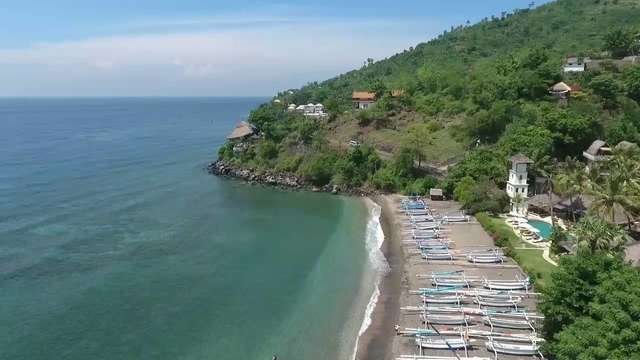
Klungkung and the Nusa Islands (Nusa Penida, Nusa Lembongan, Nusa Ceningan)
Klungkung regency governs part of eastern Bali and the three Nusa Islands. Just a short boat ride from Bali, the Nusa Islands deliver rugged coastal beauty, dramatic cliffs, and some of the best snorkeling and diving in the region. These islands are ideal for those craving outdoor adventure and raw natural landscapes.
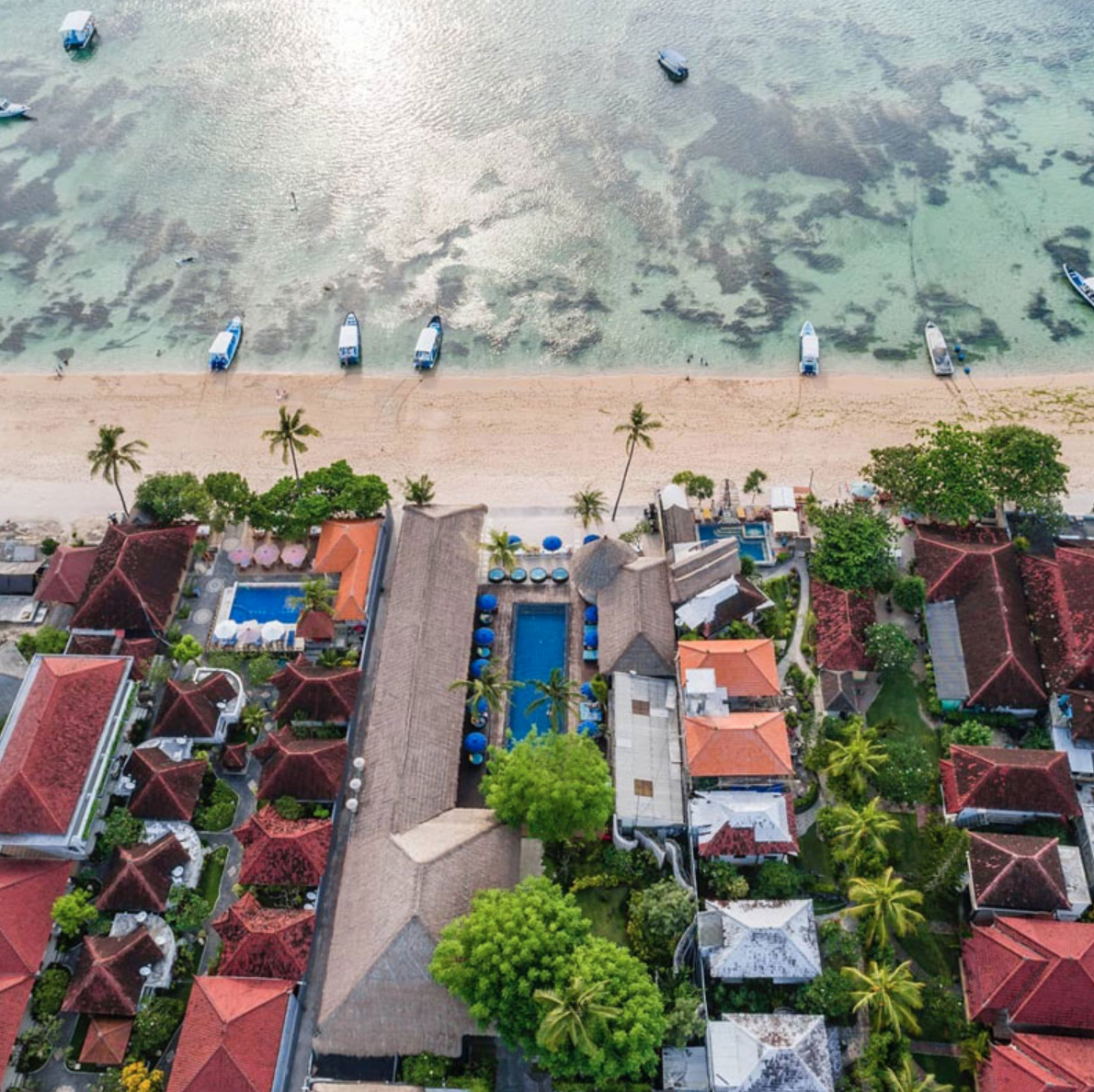
Atmosphere:
- Klungkung mainland is quiet and historical
- The Nusa Islands offer rugged coastal beauty and outdoor adventure
Accommodation:
- Mainland Klungkung: Few guesthouses and hotels.
- Nusa Penida, Lembongan, and Ceningan: Wide range from budget hostels to luxury villas.
Transport:
- On the mainland: private vehicles.
- On the islands: scooters or bicycles.
Sights and Entertainment:
- Kerta Gosa Hall of Justice in Semarapura (Klungkung town).
- Nusa Penida: Kelingking Beach, Angel’s Billabong, Broken Beach.
- Nusa Lembongan: Mangrove forests, snorkeling with manta rays.
- Nusa Ceningan: Blue Lagoon cliff jumping.
Beaches:
- Nusa Penida has stunning but rugged beaches.
- Lembongan and Ceningan offer better snorkeling and easier beach access.
Pros:
- Spectacular natural beauty
- Great for snorkeling, diving, and adventurous exploration
Cons:
- Infrastructure still developing, especially on Nusa Penida
- Rough roads on the islands
Who It’s Recommended For: Adventure seekers, snorkelers, divers, and travelers wanting raw, dramatic landscapes.
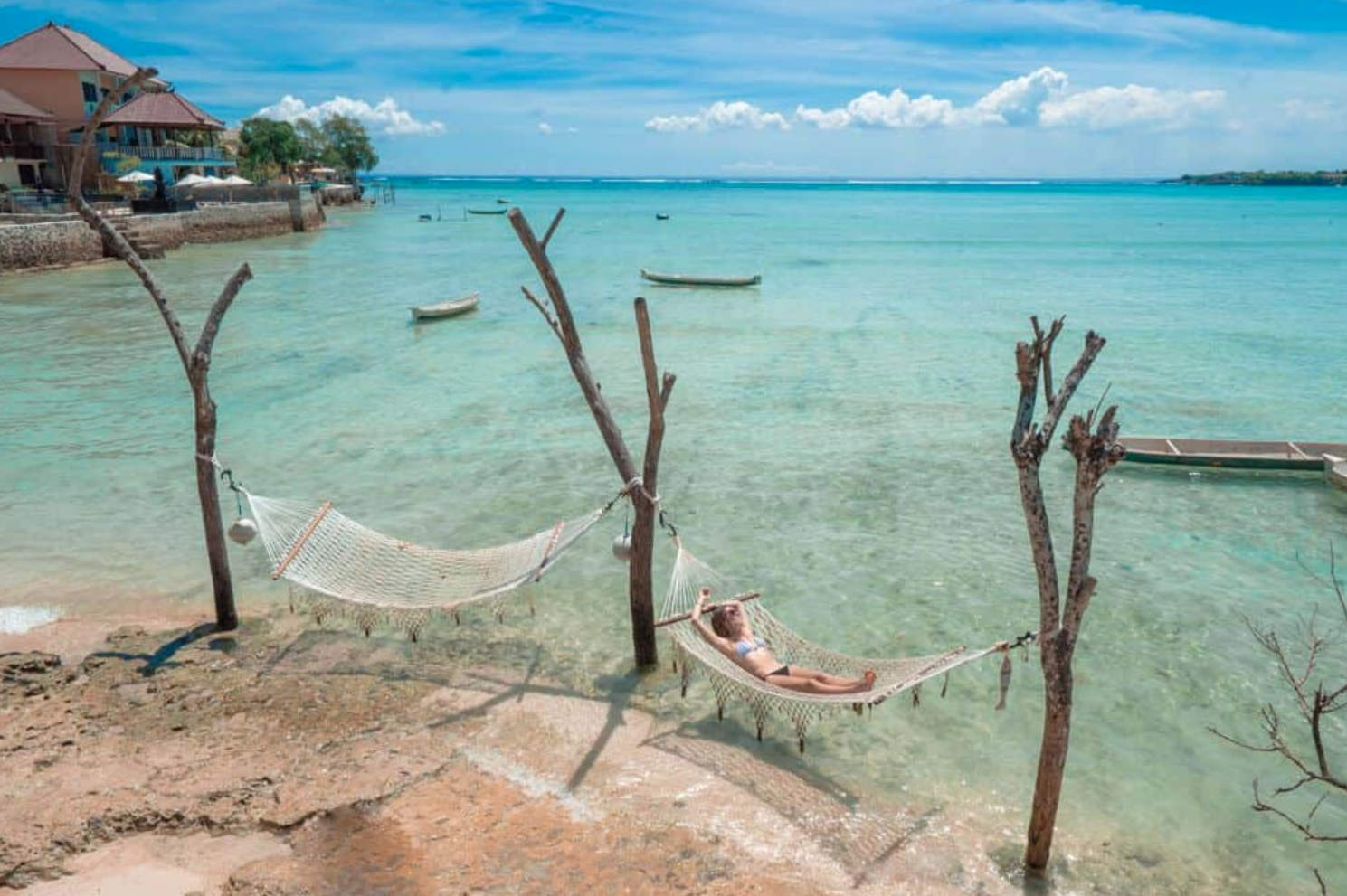
Tabanan: Nature, Rice Fields, and a New Creative Community
Traditionally rural and serene, Tabanan is now emerging as a hub for innovation and creative living. Amid endless rice fields and volcanic beaches, a new international community is taking root around Nuanu Creative City, offering a unique blend of nature, culture, and modern life.

Tabanan is a vast, scenic region stretching from Bali’s southwest beaches through the rice field heartlands to the northern highlands around Mount Batukaru.
Atmosphere: Traditionally rural and peaceful, Tabanan is known for its lush natural landscapes and authentic Balinese atmosphere. Recently, however, parts of southern Tabanan — particularly around Nuanu Creative City — have seen the emergence of a growing international community. Nuanu is transforming the region by attracting foreign residents, entrepreneurs, families, and creatives, with international schools, social hubs, and cultural events.
Accommodation: The area offers everything from budget homestays to private villas — especially around the southern coastal stretch near Canggu and the Nuanu community.
Transport: A motorbike or car is essential for getting around.Online taxis are available in some parts, but distances can be long.
Sights and Entertainment:
- Jatiluwih Rice Terraces (UNESCO World Heritage Site).
- Lake Beratan and Ulun Danu Beratan Temple.
- Mount Batukaru.
- Blahmantung Waterfall.
- Tanah Lot Temple — one of Bali's most iconic sea temples.
- Botanical Gardens for families.
- Extreme activities such as motocross through jungles and along beaches.
- Nuanu Creative City — providing cultural events, coworking spaces, social hubs, concerts, and festivals.
Beaches: Tabanan’s beaches like Balian Beach and Yeh Gangga feature dramatic black volcanic sand. These beaches are beautiful for photos, walks, and surfing, but not ideal for swimming due to strong currents.
Pros:
- Natural beauty and tranquility
- No heavy traffic or city noise
- Rich in cultural and outdoor attractions
- Thriving new international community around Nuanu
- More affordable living compared to southern Bali hotspots
Cons:
- Volcanic beaches unsuitable for relaxed swimming
- Limited selection of restaurants and nightlife (except near Nuanu)
- Underdeveloped tourist infrastructure in many areas
Who It’s Recommended For: Nature lovers, surfers, families seeking a peaceful environment close to international schools, entrepreneurs, and digital nomads attracted to creative living and social life at Nuanu.
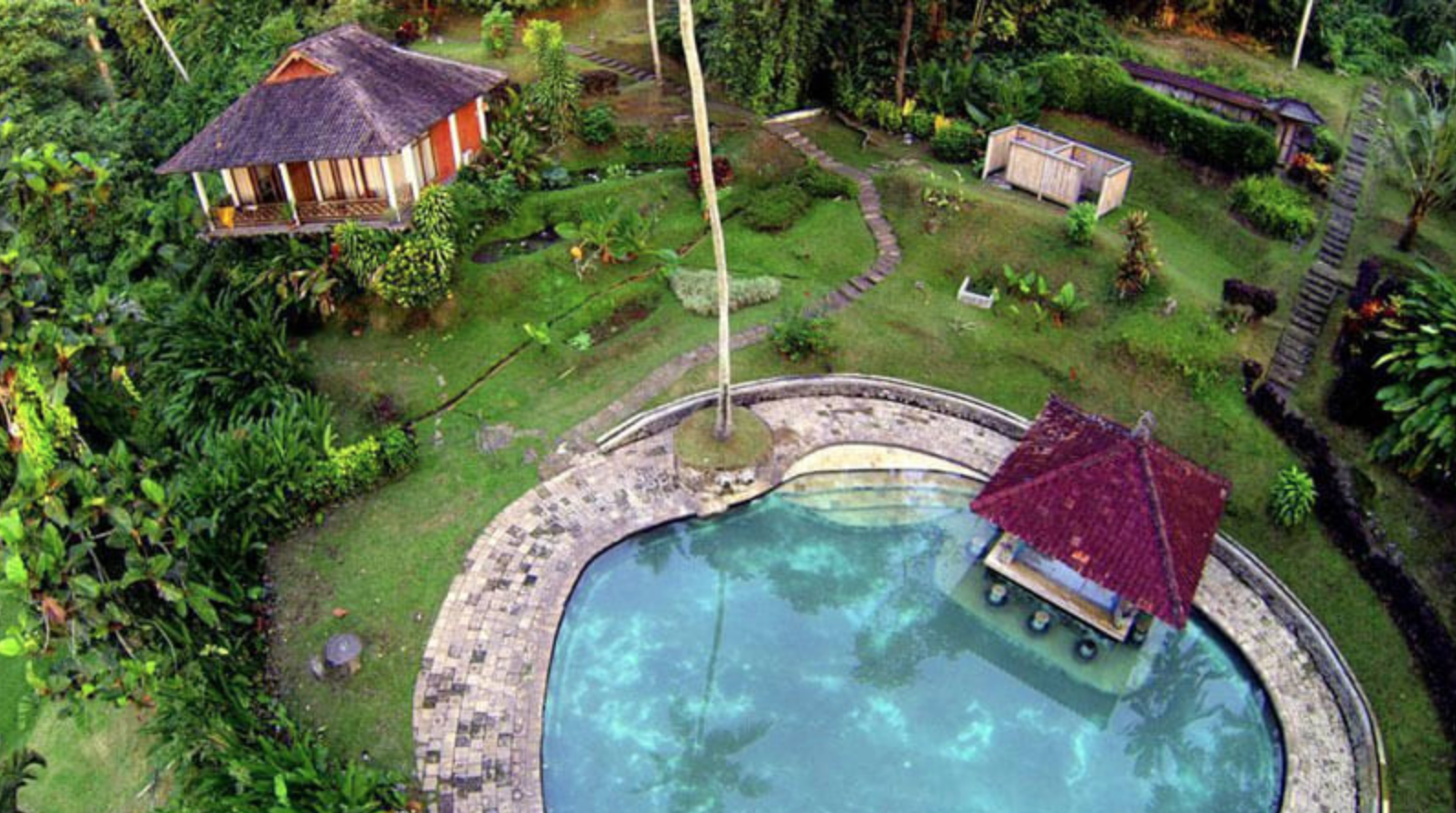
The Gili Islands: A Tropical Escape for Every Traveler
Although technically part of Lombok, the Gili Islands are a favorite extension to any Bali itinerary. Whether you're chasing parties, peaceful beaches, or underwater adventures, Gili Trawangan, Gili Air, and Gili Meno each offer their own slice of tropical paradise.
Gili Trawangan
Gili Trawangan is the largest and most lively of the three Gili Islands, located off the northwest coast of Lombok.
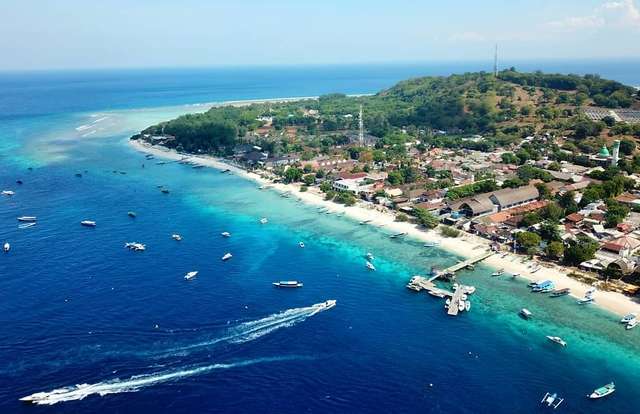
Atmosphere: Divided into two distinct sides:
- The eastern side is lively, filled with bars, beach parties, and restaurants.
- The western side is much quieter, ideal for sunset views and relaxation.
Accommodation: Everything from simple hostels to 4-star eco-resorts and luxury villas is available. The island offers options for every budget and travel style.
Transport: No motorized vehicles are allowed. Transportation is by bicycle, horse-drawn carts (cidomo), or on foot.
Sights and Entertainment:
- Underwater attractions: Artificial reefs, underwater sculptures like the famous Nest.
- Activities: Snorkeling, diving, free diving, horseback riding, parasailing, kayaking, stand-up paddleboarding, yoga, and paddleboard yoga.
- Nightlife: Bars, beach parties, live music, and fire shows dominate the eastern strip.
Beaches: The northeast side, near the port, has the best sandy beaches for swimming and snorkeling. Other areas are coral-lined and exposed at low tide.
Pros:
- Wide range of activities and entertainment
- Vibrant nightlife
- Broad accommodation options
- Friendly, youthful vibe
Cons:
- Hard to find fresh fruits and vegetables in stores
- Very lively — not ideal for travelers seeking tranquility
Who It’s Recommended For: Young travelers, party lovers, divers, and adventurous couples looking for energy and variety — eastern side for action, western side for relaxation.
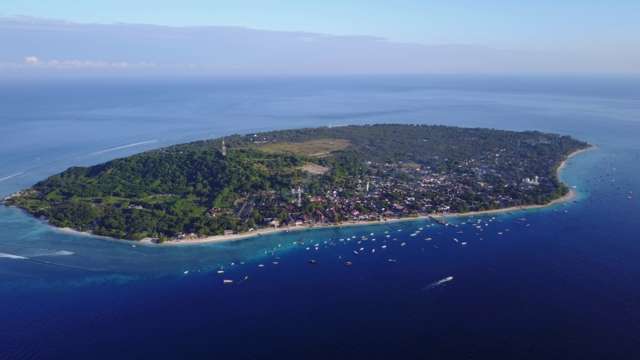
Gili Meno
Gili Meno is the quietest and most untouched of the Three Gili Islands, ideal for nature lovers and snorkelers.
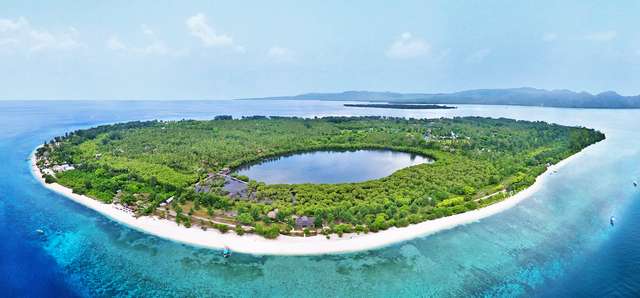
Atmosphere: Gili Meno feels remote and peaceful, with a laid-back vibe and a strong focus on nature preservation. It’s the least developed, offering pure tranquility.
Accommodation: Good selection of simple guesthouses, private villas, and a few boutique resorts.
Transport: Like the other Gilis, there are no motorized vehicles. Get around by foot or bicycle.
Sights and Entertainment:
- Lake: A small saltwater lake exists, but it’s more scenic than swimmable.
- Underwater sculpture: The Nest statue off the western coast near the Bask Hotel is a must-see.
- Activities: Snorkeling (especially with turtles), diving, horseback riding, and fishing trips.
Beaches: The best beach for swimming is southeast of the port. Good swimming is also available near Mahamaya Hotel (west) and Seri Resort (east).
Pros:
- Pristine natural beauty
- Exceptional snorkeling and diving with turtles
- Quieter and more romantic atmosphere
- Cleaner environment
Cons:
- Few restaurants and limited dining options
- Only Eka Jaya boats offer direct trips from Bali
Who It’s Recommended For: Nature lovers, honeymooners, and travelers who want to snorkel from shore and enjoy peaceful isolation.
Gili Air
Gili Air is a balanced mix of nature and light social life, offering a comfortable middle ground between Gili Trawangan’s energy and Gili Meno’s tranquility.

Atmosphere: Gili Air has a strong local community and is the most self-sufficient of the Gilis. There’s a solar power plant, and local families work to maintain and improve the infrastructure.
Accommodation: Options range from simple guesthouses to luxury private villas.
Transport: Transportation is by bicycle or on foot.
Sights and Entertainment: Snorkeling, diving, freediving, yoga (at studios like H2O and Flowers & Fire), and occasional acoustic concerts.
Beach Fun: Light parties and beach bars exist but are more low-key compared to Gili Trawangan.
Beaches: Best swimming beaches are on the southeastern coast. Some northern beaches are good too, but only at high tide.
Pros:
- Well-developed infrastructure
- Very friendly and welcoming local community
- Good mix of activity and nature
- Ideal for health-conscious travelers, yogis, and families
Cons:
- Occasional power outages
- Nightlife is more subdued compared to Gili Trawangan
Who It’s Recommended For: Families, yogis, vegans, nature lovers, and those seeking a laid-back island life without giving up some modern comforts.

Conclusion
Whether you're seeking bustling beach towns, peaceful rice fields, rugged coastlines, or creative communities, Bali offers a place for every kind of traveler and resident. Understanding the unique character of each region will help you choose the area that best matches your lifestyle, dreams, and adventures. Wherever you decide to stay, Bali’s vibrant spirit and natural beauty are always close by.
We traveled for two weeks last year 🙂
Stayed in Nusa Dua - a more upscale area, mainly with 5-star hotels.
It's very clean there and almost everywhere outside is picturesque.
Then we rented a villa in the Seminyak area (we didn't particularly like it there) although there are many shops and cafes)
Make sure to visit at least 1-2 waterfalls, whichever are closer to you)
And my personal observation - Melasti Beach (it's simply gorgeous) - go there in the morning, because in the afternoon there's a low tide and you can't really swim.
It's better to get around by bike, as traffic jams will steal half your vacation if you use a car (
It's cheaper to live in the center, for example in Ubud.
And if you're staying in a villa (or if you just have your own kitchen), it's better not to buy groceries at the supermarket; it will be more expensive than eating in cafes 🤷♀️
Hope something will be useful for you)